Publications & presentations
GDP growth – a downward trajectory?
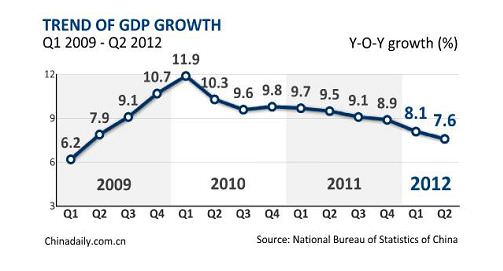
Energy consumption – a more reliable indicator?
The Economy: Not By the Numbers
- (c) Describing some of the challenges he faces as Party Secretary, Li related that despite brisk economic growth of SIPDIS 12.8 percent in 2006, Liaoning’s income gaps remain severe. Liaoning ranks among the top 10 Chinese provinces in terms of per capita GDP, yet the number of its urban residents on welfare is among the highest in the country and rural disposable incomes are above the national average. Even so, incomes for Liaoning farmers are only half that of urban residents.
- (c) GDP figures are “man-made” and therefore unreliable, Li said. When evaluating Liaoning’s economy, he focuses on three figures:
- electricity consumption, which was up 10 percent in Liaoning last year;
- volume of rail cargo, which is fairly accurate because fees are charged for each unit of weight; and
- amount of loans disbursed, which also tends to be accurate given the interest fees charged. By looking at these three figures, Li said he can measure with relative accuracy the speed of economic growth. All other figures, especially GDP statistics, are “for reference only,” he said smiling.
Source: http://wikileaks.org/cable/2007/03/07BEIJING1760.html#
- National Energy Administration recent figures shows slow down in electricity consumption
- Centres of heavy industry: Shandong Province and Jiangsu Province reported 10% drop in electricity consumption
- Coal storage reached record high at Qinhuangdao, Tianjin, Caofeidian and Lianyungang, according to Wood Mackenzie
- As electricity consumption decreases, the demand for coal also decreases hence the increase in coal storage
Decelerating construction and manufacturing sectors
- Construction and manufacturing sectors account for 75% of total energy consumption
- Manufacturing PMI down from 49.3 in July 2012 to 47.8
- An eleventh successive month-on-month deterioration
- Sharpest decline in factory output since March
- Non-manufacturing PMI, which tracks construction activity, is also well below the ten-month high in March
OR, Transition to service-based economy?
- The decrease in electricity consumption is due to structural transition to the service sector, which is less energy intensive
- According to the NEA data, the service industry and residential power consumption expanded much faster than that of the industrial sectors
- In any event, China’s economy is facing significant downward pressure due to the Euro crisis
Underlying problems of China’s economy
Figure 3. Composition of GDP growth (in percent)
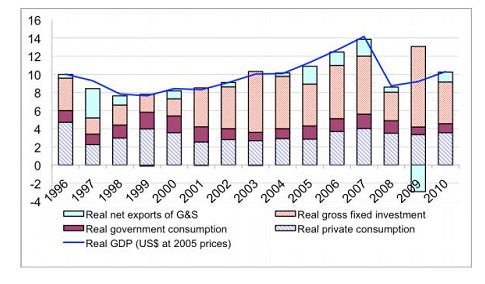
Source: EIU Country Data.
Note: Shaded regions in each bar show the contributions (in percentage points) of each component to total GDP growth. 2010 data are EIU estimates.
Figure 4. Shares of Private Consumption and Investment in GDP (in percent)
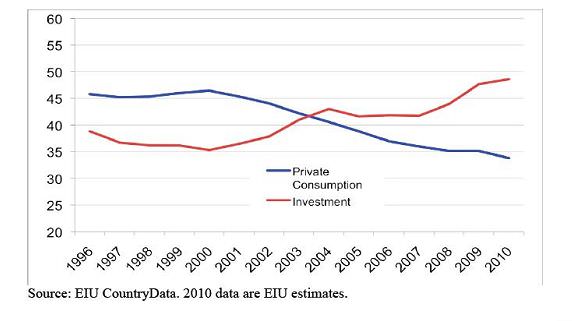
Source: EIU Country Data. 2010 data are EIU estimates.
Figure 1. Inflation (12-month inflation rates based on CPI indexes)
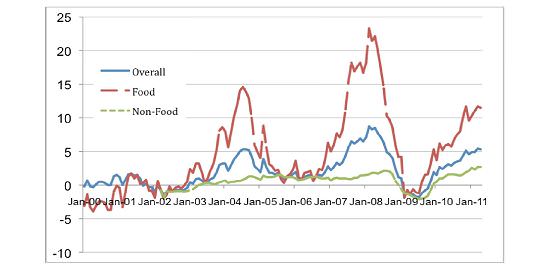
Sources: National Bureau Statistics; Haver; CEIC
Figure 5. Labor Income as Share of National Income (in percent)
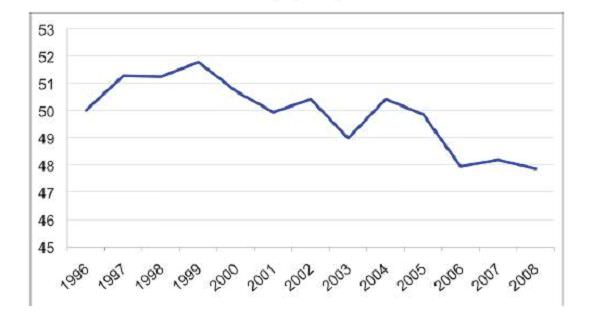
Sources: Flow of Funds data, CEIC.
Figure 6. Personal Disposable Income as Share of GDP (in percent)
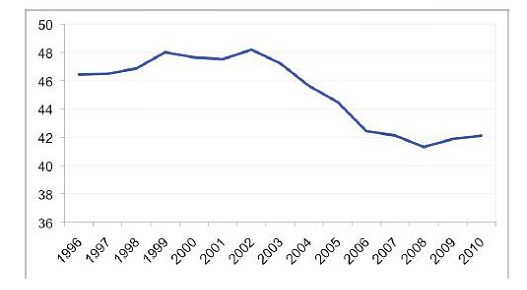
Source: EIU Country Data. 2009 and 2010 data are EIU estimates.
Why is it so difficult to boost private consumption ?
- Although the government has planned to stimulate consumption through consumer subsidies etc, these measures are not likely to offer quick results
- High inflation, combined with weak employment growth, a weak social safety net, a poor government-funded health care system and low public confidence on China’s social institutions and prospects are the key issues
- More difficult to combat these fundamental issues
Chinese government’s considerations
- increasing consumption would require the government to relinquish, rather than increase, its control over the economy
- the government remains sceptical of the contribution that domestic consumption could make to economic growth
- still prefers direct investment and public expenditure to build the economy
The financial crisis in 2008
- The Chinese government embarked on massive fiscal and monetary stimulus, which worsened the problems of high inflation and asset bubbles
- But, a U-turn would be more disastrous to employment, household income and the willingness to lend
Figure 10. Foreign Exchange Reserves (USD billion)
Foreign Exchange Reserve Stocks: 2005Q1 – 2011Q1
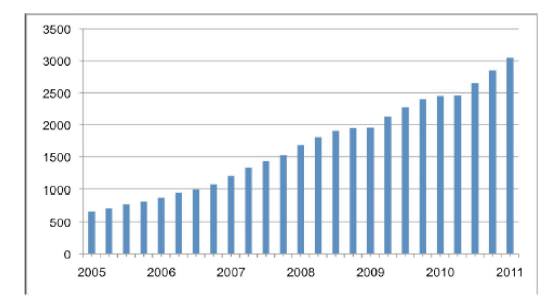
Sources: People’s Bank of China; Haver
Note: End of quarter figures
Accumulation of Foreign Exchange Reserves: 2005Q1 – 2011Q1
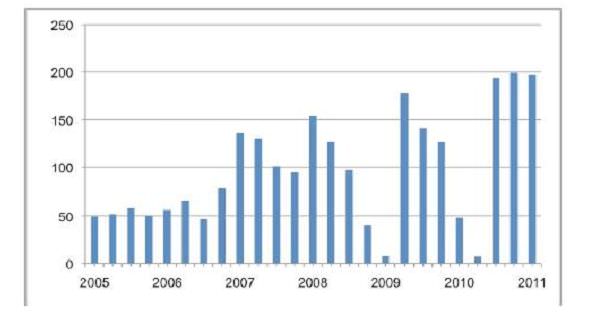
Sources: People’s Bank of China; Haver
Note: End of quarter figures
RMB internationalisation
- More exchange rate flexibility → more autonomous monetary policy in macro-economy
- Meet twin objectives of high growth and low inflation
- RMB appreciation → increase purchasing power → rebalance growth from investment and export-led economy to consumption-based economy
China’s banking system
- Notorious for its persistent incentives to lend to state-owned enterprises
- Weak risk management capacity
- Poor quality of asset portfolios
- Limited financing options for private enterprises, especially due to capital control
Benefits of making use of offshore markets
- Increase efficiency in China’s financial market
- Increase access to capital for private sector
- Better price mechanism in allocating capital
Is the level of government debt sustainable?
- National Audit Office (June 2011):
- More than 6,576 financing vehicles set up by local governments by end of 2010
- 20% of these companies were found to have defects in management
- 85% of these companies had sufficient income to cover debt servicing payment
- Total local government debt: RMB 10.7 trillion (equal to 27% of China’s 2010 GDP)
- 2010 total local government revenue: RMB 8.3 trillion
- Total local government debt could be as high as RMB36 trillion, or 90% of China’s GDP
- Of 483 urban construction investment bonds sold by local governments, 33% had negative cash flow
- Minghang District in Shanghai: 46% debt ratio of the district’s total product, with RMB 1 billion annual interest payment
- Hongkou District in Shanghai: 190% debt ratio with 200% negative cash flow
- China’s “economic tsunami”
- China’s local government debt level “unsustainable”
- Other opinions:
- Mr Cheng Siwei, former deputy head of NPC: local government debt is China’s equivalent of U.S. subprime crisis
- Mr Qu Hongbin, China chief economist at HSBC: local government debt poses a potential risk to China’s banking system
Solutions to build a sustainable economy
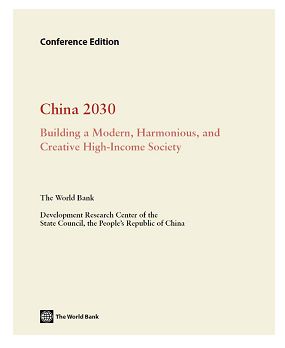
A report jointly conducted by the World Bank and the Development Research Center of the State Council of the PRC – seeking to address the underlying risks to China’s economy and find solutions to make the economy more sustainable
Six broad recommendations
- Implement structural reforms to strengthen the foundations for a market-oriented economy
- Accelerate the pace of innovation and create an open innovation system
- Seize the opportunity to develop “green” energy
- Improve social security for all
- Strengthen the fiscal system and
- Seek mutually beneficial relations with the world
Inward Foreign Direct Investment
- Inward FDI into China in 2011 hit US$116bn, up 9.7% from 2010
- China was the world’s second-largest FDI recipient in 2010
- only after the U.S.
- US$106bn
- Hong Kong has always been the major source of China’s FDI inflow.
- Other major investors in China include companies from Taiwan, Japan, Singapore and USA
Top 10 nations and regions with investment in China in 2011 (as per actual input of foreign capital)
| Rank | Nations / regions | Investment in PRC |
| 1 | Hong Kong | US$77.011bn |
| 2 | Taiwan | US$6.727bn |
| 3 | Japan | US$6.348bn |
| 4 | Singapore | US$6.32bn |
| 5 | USA | US$2.995bn |
| 6 | ROK | US$2.551bn |
| 7 | UK | US$1.61bn |
| 8 | Germany | US$1.136m |
| 9 | France | US$802m |
| 10 | Holland | US$767m |
Source: FID of MOFCOM
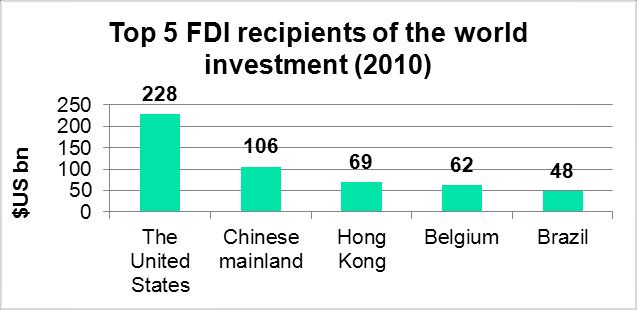

Source: China Daily
- About half of the inward FDI (~US$50bn) was invested in manufacturing projects in 2010
- Investment in China’s real estate sectors was also popular
- it accounted for one-fifth of the total FDI inflow in 2010
- Strong development in China’s poorer and less developed interior and western regions
- lower cost of labour there
- Transformation of China’s industrial structure
- manufacturing sectors → high technology sectors and services
- China’s position as the top destination for low-cost offshore manufacturing is under pressure
- rising wages, production costs and transportation costs
- With a predicted growth rate in the region of 8.4% (down from 9.2% in 2011), China remains an attractive investment destination
- China is targeting annual inward FDI of US$120 bn by 2015
- Rapid expansion of Chinese consumer market will mean China continues to attract FDI inflows, particularly in the service sector
- FDI predicted to continue to flow to booming inland cities in search of cheaper labour and fast growing markets
- End of 2011, China saw decline in FDI from U.S. and Europe as developed countries struggled to keep economies afloat
- China’s 2012 target: to stabilise scale of FDI and improve quality
- Aim to bring high-tech and management experience from developed countries to transform China to innovative economy
- Foreign investment encouraged in non-traditional sectors
- During 5-day visit to US by Vice-President Xi Jinping, a package of agreements worth US$38.6 billion was agreed, including 25 investment projects by US investment companies in China
NEW POLICIES ON FDI IN CHINA
Foreign Direct Investment in China
- In 2009, China was the second largest recipient of FDI, attracting US$95 billion
- In 2010, China attracted FDI of US$105.7 billion
- In the months to November 2011, FDI into China reached US$103.8 billion
Opinions on Further Improving the Work of Utilizing Foreign Investment (“2010 State Council Opinions”)
- Issued by the State Council of China on 13 April 2010
- A high level policy document spelling out broadly the industries and geographic regions in which foreign investment is to be encouraged
- cover five key areas:
- promoting foreign investment in specific high tech and environmentally friendly industries
- encouraging foreign investment in China’s central and western regions
- diversifying the use of foreign investment
- streamlining the foreign investment approval system
- improving the investment environment for foreign investors
Promoting foreign investment in specific high tech and environmentally friendly industries
The 2010 State Council Opinions confirmed that the Foreign Investment Catalogue would be revised to encourage foreign investment in:
- high-end manufacturing
- high-tech development
- modern services
- new energy
- environment protection
- energy saving
Foreign investment in high polluting and high-energy-consuming projects or in industries already suffering from overcapacity, would be restricted
Specific measures to benefit qualified foreign investment include:
- the introduction of an exemption for qualified foreign-invested research and development centres from China customs duty and value-added tax on the import of goods required for research work
- discounted land prices at 70% of the statutory minimum price for some qualified projects failing under the “encouraged” category
- the improvement of procedures for determining new and high technology enterprises to enable foreign invested enterprises (“FIEs”) to benefit from the status
Encouraging foreign investment in China’s central and western regions
- the encourage FDI in labour intensive industries meeting environmental protection standards
- local governments to offer incentives (e.g. preferential corporate income tax treatment)
- Foreign banks encouraged to set up operating branches in the central and western regions
Diversifying Foreign Investment
- foreign investors to be encouraged to buy into Chinese enterprises through mergers and acquisitions
- foreign investors encouraged to become strategic investors in companies listed on China’s domestic stock exchanges
- China will expand the qualifications for foreign issuers authorized to issue RMB-denominated bonds
- China aims to list more qualified FIEs on its domestic stock exchanges
- China will expedite, on a pilot basis, market opening to foreign-invested guarantee companies
- China to encourage investment from foreign-invested venture capital and private equity funds, and improve exit mechanisms
FDI Approval System Reform
Commitment to streamlining and simplifying China’s foreign investment approval process
Provincial level branches of MOFCOM and the National Development and Reform Commission (NDRC) should have authority to approve foreign investment projects with a total investment amount of up to US$300 million (increased from US$100 million) in the “encouraged” or “permitted” categories under the Foreign Investment Catalogue
Increased threshold does not apply to projects expressly reserved for approval at the central government level
The threshold for foreign-invested projects under the “restricted” category requiring central level approval remains at US$50 million
The increased approval authority of provincial level authorities formally implemented by MOFCOM’S “Circular on Delegating the Examination and Approval Power for Foreign Investment Projects” (10 June 2010) and the NDRC’S “Circular on Effectively Delegating Approval Authority for Foreign-Invested Projects” (4 May 2011)
Improvements to the Investment Environment for Foreign Investors
Proposals include:
- measures to improve foreign exchange control procedures for foreign invested enterprises
- regulators to be permitted to delay or extend the approved capital contribution schedule for foreign investors encountering temporary financial difficulties
12th Five Year Plan – Strategic Emerging Industries (SEI)
- Approved by the National People’s Congress in March 2011
- Key aspects: economic restructuring, the environment and energy efficiency, scientific development and developing SEIs
- Introduces 7 strategic emerging industries (“SEI”) designated as the drivers for China’s future economic development
The seven SEIs are:
- Bio-technology
- New energy
- High-end equipment manufacturing
- Energy conservation, environmental protection
- Clean-energy vehicles
- New materials
- Next-generation IT
Central government aims to grow these seven industries from 5% of GDP in 2010, to 8% by 2015 and 15% by 2020
Guiding Opinions on Promoting the International Development of Strategic Emerging Industries
- jointly issued by MOFCOM and the NDRC on 8 September 2011
- provide a broad framework for adoption of specific policies to develop SEIs and to attract FDI in SEIs
- FDI in SEIs to be actively promoted
- R&D by foreign investors and joint sino-foreign R&D to be encouraged
2011 New Guidelines for Foreign Direct Investment
- Catalogue for Guiding Foreign Investment in Industry (Foreign Investment Catalogue) revised December 2011 (“New Catalogue”)
- New Catalogue came into force on 30 January 2012 replacing the 2007 version
- Cornerstone of China’s regulatory regime for foreign investment
- Structure unchanged: divides China’s industrial sectors into “encouraged,” “restricted” and “prohibited” categories
- New Catalogue reflects priorities established by the 2010 State Council Opinions and the 12th Five Year Plan
- Prioritizes foreign investment in high-technology industries, high-end manufacturing, energy conservation, environmental protection and advanced services
Further opening-up to foreign investment
Compared to the 2007 catalogue, the New Catalogue :
- increased the number of industries in the encouraged category by 3 to a total of 354 industries
- removed 7 industries from the “restricted” category to leave 80 industries in this category
- removed 1 industry from the “prohibited” category leaving 39 industries in this category
- reduced by 11 the number of industries subject to restrictions on foreign investment equity ratio
Encourage transformation and upgrading of the manufacturing industry
- new products and technologies in the textile, chemical and mechanical manufacturing industries added to the “encouraged” category
- collection and treatment of waste electronic appliances and electronic products, mechanical and electrical equipment, and batteries added to the “encouraged” category
- whole vehicle manufacturing removed from the “encouraged” category
- production of polysilicon and chemical products using coal as a raw material removed from the “encouraged” category
Cultivation of strategic new industries
- foreign investment encouraged in the seven strategic emerging industries identified under the 12th Five Year Plan
- manufacture of key component parts for new energy vehicles and next-generation internet system equipment based on IPv6 added to “encouraged category”, and removes the equity ratio requirement for new energy electricity-generating equipment
Promotion of the development of service industries
- nine service industries added to the “encouraged” category including motor vehicle charging stations, venture capital enterprises, intellectual property rights services, marine oil pollution clean-up services and vocational skills training services
- medical service institutions moved from the “restricted” to the “permitted” category
- Financial leasing companies moved from the “restricted” to the “permitted” category (but foreign investment in banks and other financial institutions (including insurance companies) remains restricted)
- in the real estate sector, construction of villas (single family homes) moved from the “restricted” to the “prohibited” sector
Promote coordinated regional development
- items removed from the “encouraged” category may be included in the proposed revisions to the Catalogue for Guiding Foreign Investment in the Dominant Industries of the Central and Western Regions 2008 expected this year
- will encourage foreign investment in labour-intensive projects that meet environmental protection requirements in central and western regions
Relationship with other industrial policies and Bilateral Treaties
- in case of discrepancies between Catalogue and other industrial policies, State Council rules or treaties that China has entered into with other countries, the latter will prevail
China Approves 12th 5 Yr Plan for Western Regions
- 20 February 2012: China State Council announced approval of 12th Five Year Plan for Further Promoting the Economy of the Western Regions
- Aim: narrow gap between wealthy coastal regions and under-developed western regions
- 12 provinces: Xinjiang, Tibet, Inner Mongolia, Guangxi, Ningxia, Gansu, Qinghai, Sichuan, Chongqing, Shaanxi, Guizhou and Yunnan consolidated into economic zones
- Key to success will be infrastructure development
- Western China to be better integrated in national transport network by connecting it with booming Yangtze River Delta, Pearl River Delta and Bohai Bay Zone Regions
- Region’s railway network expected to expand by circa 15,000 km by 2015. Investment in highways, airports, and oil and gas network expected
- Over last 5 yrs, western provincial economies expanded by average of 13.6% and over 365,000 km of highways and 8,000 km of railways built
- Plan has strong ecological focus: by 2015, almost 20% of land is required to be covered by forests
- 15% cut in energy use per GDP unit required from that at end of 2010
Cross-border Direct Investment in RMB
- MOFCOM issued the Notice on Cross-border Direct Investment in RMB on 12 October 2011 (“MOFCOM Notice”)
- “Cross-border direct investment in RMB” refers to direct investment in a Chinese company by a foreign investor using legitimately obtained offshore RMB funds.
- RMB funds will be “legitimately obtained” if :
- obtained from RMB settlement of cross-border trade
- RMB profits and RMB funds from share transfer, capital reduction, liquidation and advance recovery of investment obtained from within China and remitted out of China
- raised outside China, including from offshore issues of RMB-denominated bonds or other securities
- offshore RMB can be invested in any industry (subject to compliance with all other regulations governing foreign investment), but using offshore RMB to purchase Chinese listed securities or financial derivatives or for entrustment loans is prohibited
FDI made in RMB subject to the same rules and regulations governing foreign investment as investments made in foreign currencies, including the requirement for approvals from Central MOFCOM or its provincial counterparts
Central MOFCOM approval required for:
- investment of RMB funds of RMB 300 million or more
- investment in the sectors of financing guarantee, financial leasing, microfinance or auction
- investment in a foreign-funded investment company, a foreign-funded venture capital enterprise or a foreign-funded equity investment enterprise
- investment in an industry under the macroeconomic control of the government, such as cement, iron and steel, electrolytic aluminum and shipbuilding
Additional documents to be submitted for RMB FDI are:
- a certificate or explanation as to the source of the RMB funds
- a statement as to how the funds will be used
- a standard government form, the Statement on Cross-border Direct Investment in RMB
PBOC Administrative Measures on RMB Settlement in Foreign Direct Investment
- published by PBOC on 13 October 2011
- significantly simplify approval process for repatriating RMB funds to China
- repatriation of offshore RMB to foreign-invested enterprises no longer requires PBOC approval, whether in the form of debt or capital contribution
- application for opening an RMB settlement account need only be made to the Chinese receiving bank which is then required to make a filing with the local branch of PBOC only after opening of the account
- Chinese receiving banks given primary responsibility for monitoring the use of RMB funds repatriated into China
Relaxation of withholding tax on earnings of foreign companies
- The SAT reduced the withholding tax on dividends repatriated from China by 50% (from 10% to 5%)
- The new tax reduction also applies to QFII
- The new tax reduction will only apply to companies and shareholders based in foreign countries where they have double taxation agreements with China, including Hong Kong, Singapore and United Kingdom
- The current arrangement does not have any conditions attached, unlike the previous reduction in 2009
- In 2011, almost USD 65 billion of dividends was repatriated and USD 8.6 billion withholding tax was collected
- It is hoped that the reduction can save foreign investors billions of dollars of tax payments, therefore encouraging more foreign investments in China
CHINA’S MINING LAW
Key facts of China’s mineral reserves
- 92% of the country’s primary energy
- 80% of the industrial raw and processed materials
- 70% of the agricultural means of production
…come from mineral resources in China
General characteristics
- Fairly large in quantities
- Fairly complete in variety
- Geographic mismatch between production and consumption
- Superior ores exist side-by-side with inferior ores
| Characteristics | |
| Eastern region |
|
| Central region |
|
| Western region |
|
- Core policy: rely on foreign capital and technology for exploitation of domestic mineral resources
- All mineral resources belong to the Chinese government
- Major legislation: Mineral Resources Law (amended in August 1996)
- Main authority: the Ministry of Land and Resources
Exploration of mineral resources
- Exploration permit:
- Issued in the form of 3-year leases renewable upon discovery of resources
- Rights
- A priority and an exclusive right to obtain the “mining right”
- Transfer the exploration permit subject to approval and compliance with exploration expenditure
- Obligations:
- Pay scheduled minimum exploration expenditure and permit fees
- Commence and complete the exploration within the term
- No unauthorised mining activities
- Reports on regional geological surveys
- Submit a preliminary comprehensive assessment regarding the mineral deposits explored
- Comply with safety requirements when exploring fragile, explosive and radioactive minerals
Sample of an exploration permit
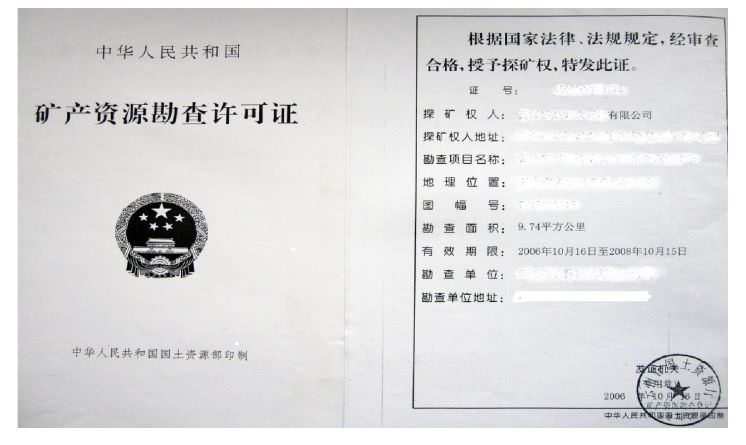
- Documents to be submitted for forming foreign-invested exploration enterprise (Article 8 of “Measures for the Administration of Foreign-Invested Mineral Exploration Enterprise”):
- Application
- Feasibility study report
- Contract and bylaws
- List and letters of appointment of board directors
- Notice of pre-approval of enterprise name issued by administrative department of industry and commerce
- Registration and credit certifications
- A statement on the formation of exploration rights and survey input (if applicable)
- A statement on the status of business operation
- A land use right certificate
Mining of mineral resources
- Mining rights:
- Holders called “concessionaires”
- For large mining projects, maximum term is 30 yrs
- For smaller mining projects, the term may be lowered to 10 yrs
- Rights:
- Sell the mineral products privately
- Gold and silver can now be sold freely
- Obligations:
- Commence mining within the terms of the mining permit
- Adopt rational and proper mining methods
- Observe labour, production safety and health and environmental laws
- Rehabilitate the land to its previous conditions if damage is done
- Obtain approval before construction of infrastructures necessary for the mining
- Pay resources tax and compensation RMB 1,000 per sq. km. of mining area per annum
Sample of a mining right permit
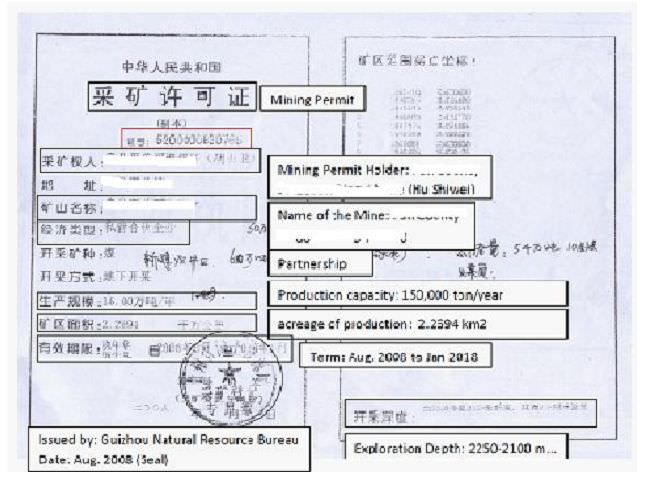
Foreign investment
| Mineral resources | |
| Encouraged projects | Coal-bed gas, mine gas, oil & natural gas, low permeability oil & gas, technology for enhanced oil recovery, technologies for geophysical prospecting, drilling, well logging, mud logging, down-hole operation, oil shale, oil sand, heavy crude oil, extra-heavy crude oil, shale gas and marine gas hydrate |
| Restricted projects | Rare coal, barites, precious metal, diamonds, high-aluminum fireclay, wollastonite, graphite, szaibelyite, ludwigite, celestite, marine manganese nodule |
| Prohibited projects | Tungsten, molybdenum, tin, stibonium, fluorite, rare earths minerals, radioactive minerals |
Since April 2010, any encouraged projects with investment less than USD 300 million can be approved at local level instead of central government level
Tax
- Taxes include:
- Value-added tax
- Mineral resources compensation
- Corporate income tax
- City construction tax
- Land use tax
- Business tax
- New resources tax
- Instead of taxing based on output volume, the new resources tax regulation imposes a 5% – 10% levy on the basis of sales amount
Environmental protection
- Requirements:
- Registration with environmental protection authorities
- Prepare a report on the environmental impact of any mining infrastructure
- Pay air pollutants and wastewater discharge fees
- Install de-sulphurising devices for discharge of sulphur dioxide
Production safety
- Requirements:
- Must hold valid production safety certificate
- Allow inspection of relevant authorities
- Install at least two safety exits for each underground mine shaft
- Equip mines with transportation and communication facilities connecting the mine to the outside
- Only trained workers are allowed to work in mines
WTO Disputes
WTO ruling
- Highlights:
- China’s restrictions on mineral exports violate WTO rules
- Rare earths minerals were not the subject of the ruling
- But … the ruling may have important implications for China’s restrictions on exports of rare earths minerals
- Now, China holds 37% of the world’s known reserves and produces 95% of rare earths minerals
- Rare earths minerals are considered strategic resources of China
- China has indicated its intention to comply with WTO
- Therefore, China might need to further open up its market of strategic minerals to foreign enterprises
Recent development – WTO Complaint
- Highlights:
- the US, Japan and the European Union jointly filed a case of complaint against China at the WTO, challenging China’s restriction on rare earth exports
- China indicated its intention to defend the case
- But … Two months following the filing of complaint, China decided to allow 11 more companies to export rare earths
- Export quota increased by 10,680 tonnes, on top of the 10,546 tonnes initially allowed for the year
- China is set to release additional annual quotas during the summer which is likely to match last year’s quota
China’s Anti-Monopoly Law
- China’s Anti-Monopoly Law (“AML”) came into effect on 1 August 2008
- Supplemented by a number of implementing rules and guidelines
AML prohibits three types of monopolistic conduct:
- “monopoly agreements” (i.e. anti-competitive agreements) made between business operators
- abuse of a dominant market position
- concentrations of business operators (inc. mergers/acquisitions) that may eliminate or restrict competition
Chapter V AML prohibits the abuse of administrative powers to restrict competition
The Enforcement Agencies
3 Anti-Monopoly Law Enforcement Agencies (“AMEAs”):
- Anti-monopoly Bureau of the Ministry of Commerce (“MOFCOM”) – responsible for merger review
- National Development & Reform Commission (the “NDRC”) – responsible for price-related anti-competitive agreements, abuse of market dominance and abuse of administrative power
- State Administration for Industry and Commerce (“SAIC”) – responsible for non-price related anti-competitive agreements, abuse of market dominance and abuse of administrative power
Primary enforcement focus to date – merger control
Up to mid-December 2011, some 369 merger applications reviewed – vast majority (97%) cleared unconditionally
Only one merger application rejected outright (Coca Cola’s proposed 2009 acquisition of Huiyuan juice)
To date, 15 mergers have been approved subject to conditions
Far fewer enforcement actions of anti-competitive agreements and abuse of market dominance
2011/2012 Update
Clear signs that enforcement authorities ready to step-up enforcement actions
NDRC and SAIC issued 5 new implementing rules – greater clarity re. conduct prohibited under anti-competitive agreements and abuse of dominance provisions
NDRC imposed highest fine to date (US$1.1 million) on 2 pharmaceutical companies for market division and price fixing
NDRC’s anti-trust investigation into China’s two largest state-owned telecommunications companies – China Telecom and China Unicom
Mergers – 4 conditional clearances in 2011, 5 conditional clearances in 2012
February 2012 implementation of new MOFCOM Rules imposing fines for failure to notify a merger
New National Security review process implemented
Monopoly Agreements
“Monopoly agreements” = agreements, decisions or other concerted behaviour that eliminate or restrict competition
Specific types that are prohibited:
- horizontal monopoly agreements between competing business operators, which:
- fix or change the price of commodities
- restrict the production quantity or sales volume of commodities
- divide the sales market or raw materials supply market
- restrict the purchase of new technology or new facilities, or restrict the development of new technology or new products
- jointly boycott transactions
- any other monopoly agreements as determined by the relevant Anti-monopoly Law Enforcement Agency (Article 13 AML)
- vertical monopoly agreements between business operators and their trading partners, which:
- fix the resale price of commodities to third parties
- restrict the minimum resale price of commodities to third parties
- of a type specified by the relevant Anti-monopoly Law Enforcement Agency (Article 14 AML)
Possible Exemptions
Possible exemption for monopoly agreements having valid purpose:
- improving technology or researching and developing new products
- improving product quality, reducing costs, increasing efficiency, unifying product specifications and standards, or implementing a division of labour based on specialisation
- improving the efficiency and competitiveness of small and medium-sized enterprises
- a purpose in the public interest – e.g. conservation of energy or environmental protect
- mitigating a severe decrease in sales volume or excessive over-production during an economic recession
- protecting the legitimate interests of foreign trade or foreign economic cooperation
AND business operators must be able to prove:
- agreement will not substantially restrict competition in the relevant market and
- Consumers will benefit from the agreement (Article 15 AML)
Penalties
Penalties include:
- Orders to cease prohibited conduct
- Confiscation of illegal gains
- Fine of between 1% and 10% of the entity’s turnover for previous year (unclear if fines based on world-wide or China-wide turnover)
Where monopoly agreement not yet implemented – fine of up to RMB500,000
Trade associations that breach AML by facilitating the entering into of anti-monopoly agreements by members – fine up to RMB500,000 or loss of authorisation status
Abuse of a Dominant Market Position
Business operators with a dominant market position prohibited from:
- selling commodities at unfairly high prices or buying commodities at unfairly low prices
- selling commodities at prices below cost without legitimate reasons
- refusing to transact without legitimate reasons
- compelling the counter party to trade exclusively with party in a dominant market position or its designated party
- imposing unreasonable trading conditions or “tie-ins” to sales without legitimate reasons
- applying discriminatory treatment on transaction terms (e.g. prices) to counter parties of equal standing
- any other behaviour that abuses the dominant market position as determined by the AMEA (AML Article 17)
Abuse of a Dominant Market Position
Definition of “dominant market position”
“Dominant market position” = position of a business operator able to:
- control price or quantity of products or other trading conditions in relevant market or
- block or affect ability of other business operators to enter relevant market
“Other trading conditions” include commodity grades, terms of payment, methods of delivery, after-sale services etc
Factors in determining existence of dominant market position:
- business operator’s market share and competitive status in relevant market
- business operator’s ability to control sales market or raw materials supply market
- business operator’s financial position and technical prowess
- extent to which other business operators rely on the business operator
- degree of difficulty for other business operators to enter relevant market
- other relevant factors (Article 18)
Presumption of dominant position
Rebuttable presumption of a dominant market position previously where:
- sole business operator has market share of half or more
- 2 business operators have joint market share of two-thirds or more
- 3 business operators have joint market share of three quarters or more (Article 19)
No dominant market position under (b) or (c) for business operator with market share < 10%
Penalties
Penalties: orders to cease prohibited conduct, confiscation of illegal gains and fines of 1% – 10% of previous year’s turnover
Supreme Court’s Regulations on issues in civil cases arising from monopolistic conduct
- the plaintiff bears the burden of proof of dominant market position and abuse
- the plaintiff may use publicly available information as prima facie evidence of dominance
- once dominance and abuse are established, the defendant bears the burden to establish acceptable justification
Public utility enterprise and monopoly protected by law
- the court can conclude the existence of dominant market position having regard to the market structure, competitive status of the enterprise and any other evidence tendered by the defendant
Abuse of Administrative Power
Administrative bodies prohibited from exercising powers to eliminate/restrict competition
- designating suppliers of goods or services and compelling others to use them
- prevent the free circulation of goods or services by:
- setting or implementing discriminatory charges or fixing discriminatory prices for non-local commodities
- imposing technical requirements or inspection standards that discriminate in favour of local commodities
- adopting administrative licensing aimed at non-local commodities
- setting barriers or taking other measures to restrict commodities from outside the region entering the local market or local commodities from moving outside the local region
- operating bidding procedures which favour local suppliers
- restricting investment or preventing non-local companies establishing presence through requirements not applicable to local counterparts
- compelling business operators to engage in prohibited conduct
New 2011 NDRC and SAIC Rules
1 February, 2011 – 5 sets of implementing rules came into effect
NDRC Rules are:
- the Rules on Anti-Pricing Monopoly
- the Rules on the Administrative Procedures of Anti-Pricing Monopoly
SAIC Rules are:
- the Rules on Prohibiting Monopoly Agreements
- the Rules on Prohibiting the Abuse of Dominant Market Positions
- the Rules on the Abuse of Administrative Authority to Exclude or Restrict Competition
NDRC Rules deal with price-related AML infringements: SAIC Rules deal with non price-related infringements
NDRC Rules = first price-related regulations published by the NDRC
Key points on Monopoly Agreements
- NDRC and SAIC Rules define “concerted practices” – but with slight differences
- concerted practice if evidence of parallel conduct and communications between competing companies
- NDRC will take into account market structure and market trends
- SAIC will consider parties’ reasonable explanations
NDRC Rules give examples of prohibited pricing agreements between competitors:
- fixing or changing prices
- fixing or changing range of price variation
- fixing or changing fees affecting prices or discounts
- using agreed prices as basis for third party dealings
- agreeing standard formula for price calculation
- providing prices will not be changed without the consent of competing companies party to the agreement
- disguised forms of price-fixing e.g. restricting supplies to artificially inflate prices
Prohibited non-price related anti-competitive agreements include:
- restrictions on production or sales
- market sharing and customer allocation including allocation of raw materials procurement or suppliers
- restricting purchase of new technology or equipment or restricting development of new technology or products
- joint boycotts of customers or suppliers
Vertical agreements – only fixing of resale price and setting minimum resale price are prohibited
Trade associations prohibited from:
- formulating rules or issuing orders restricting competition
- arranging for members to enter into anti-competitive pricing agreements
Key Points on Abuse of Market Dominance
NDRC Rules elaborate on prohibited pricing practices for companies in dominant market position, including:
- selling products at substantially higher prices than same products sold by other companies or purchasing products at substantially lower prices
- price discrimination among parties of equal standing
- increasing sales price (or decreasing purchase price) “beyond a normal range” when costs are stable
- increasing sales price substantially higher than cost increase or decreasing sales price substantially lower than cost decrease
- selling below cost price
- refusing to trade by setting “extraordinarily” high or low prices
- trade exclusivity through use of a price discount
- imposing “unreasonable” charges
Except for charging substantially higher prices than competitors, under NDRC Rules there is no abuse if business operators can justify conduct
Sales below cost can be justified for:
- sales of fresh, seasonal, expiring or overstock goods
- sales due to debt payment, transfer of business or going out of business
- promotion of new products
Refusing to trade by setting “extraordinarily” high or low prices justified if counterparty:
- has bad credit history or deteriorating operations
- can purchase / sell same or substitute goods at reasonable price
Non-price related abuse of dominant market position includes, without justification:
- refusal to deal, including by limiting sales volumes or delaying transactions
- imposing exclusivity obligations
- tying products or imposing other unreasonable transaction terms
- other forms of discrimination
SAIC Rules give no specific examples of acceptable “justification” of prohibited conduct
SAIC considers whether conduct:
- is part of business operator’s normal business
- is the public interest and its effect on national economy
Key Points concerning Abuse of Administrative Authority to Eliminate or Restrict Competition
Further detail of types of prohibited conduct on part of administrative bodies:
- administrative bodies prohibited from abusing powers to restrict entry of non-local products through discriminatory charges or prices
- administrative bodies cannot compel business operator to breach new rules or restrict competition
- if so, both the administrative body and business operator will be liable for the anti-competitive conduct
NDRC’s Procedural Rules
Give AML enforcement authority to price administration departments at provincial level
Investigative power can be delegated to price administrative department at next level below
Important cases to be handled by NDRC
Business operator under investigation can apply for suspension of investigation if it commits to eliminate consequences of anti-competitive behaviour
- 1st business operator to report a price-related monopoly agreement and provide material evidence may be granted full immunity from penalties
- 2nd business operator reporting monopoly agreement may be given a reduced penalty of no more than 50% of statutory sanction
- Business operators who subsequently report may be given reduced penalties of no less than 50% of statutory sanction
SAIC’s Procedural Rules
Under SAIC’s June 2009 procedural provisions, different leniency provisions:
- 1st business operator to report infringing conduct will be granted immunity (under NDRC’s provisions, immunity is discretionary)
- no leniency for business operators subsequently reporting
- no leniency for ring-leaders
Possibility of forum shopping?
Possible overlapping jurisdiction of NDRC and SAIC?
Enforcement Decisions against Anti-Competitive Agreements
The Rice Noodle Cartel (30 March 2010)
- Finding: 33 rice noodle producers colluded to raise prices
- Violation of the Price Law, the AML and related regulations
- 3 organizers of cartel each fined RMB 100,000
- 18 participants fined between RMB 300,000 and RMB 800,000
- 12 participants who cooperated received administrative warnings only
Paper Manufacturing Cartel (4 January 2011)
- Fuyang Paper Making Industry Association (“Association”) organized meetings to coordinate prices of paper product
- Association breached AML and Price Law for facilitating members’ engagement in monopolistic conduct
- Association fined RMB 500,000
Cement Cartel (26 January 2011)
- SAIC’s first published enforcement decision under AML
- Non-price related cartel organized by trade association between 16 concrete producers
- Trade association had divided market and sold zones of control to members
- Association members also in breach for entering monopoly agreement to divide market
- Trade association fined RMB 200,000 for organizing cartel
- 5 members fined total of just over RMB 530,000 and illegal gains
Unilever Price Signalling (6 May 2011)
- Wide-spread media reports of plans of Unilever (and 3 other companies) to raise prices of consumer products
- Panic buying led to NDRC investigation
- 1st time NDRC fined a foreign company under Price Law
- Unilever fined RMB 2 million
- NDRC noted that Unilever’s press announcements could have amounted to “price concerted practices” in breach of AML (potentially far higher fine of up to 10% of previous year’s turnover)
“Shuntong” & “Huaxin” Price Cartel (14 November 2011)
- Shuntong and Huaxin signed exclusive sales agreements with China’s only producers of raw material for blood pressure tablet, then raised price
- Shuntong and Huaxin fined total of about US$1.1 million (including confiscated gains) for monopolizing bulk sales of raw material
- Highest fine imposed to date for anti-competitive conduct
- First pharmaceutical sector antitrust action under AML
Enforcement Actions for Abuse of Dominant Market Position
Wuchang Salt Company Tying Case (15 November 2010)
- Only published decision on abuse of dominant market position
- Wuchang branch of Hubei Salt Group Co., Ltd. (“Wuchang Salt”) made its supply of salt to 2 local distributors conditional on purchase of washing detergent powder, another of Wuchang Salt’s products
- Wuchang Salt, only company authorised to sell salt in the area, held a dominant market position
- Finding: Wuchang Salt had engaged in anti-competitive tying
NDRC’s Investigation of China Telecom and China Unicom
- November 2011, NDRC confirmed investigation of China Telecom and China Unicom for alleged abuse of a dominant market position in the broadband access market
- Most high profile investigation under AML to date
- 1st antitrust investigation of SOEs
- NDRC preliminary finding of joint market share of > two-thirds of broadband access market = dominant market position
- Preliminary finding that companies charged competitors significantly higher prices than non-competitors (i.e. price discrimination)
- China Telecom and China Unicom have applied to the NDRC to suspend anti- trust investigation
Enforcement Actions For Abuse Of Administrative Power
- 2011 saw first enforcement action for abuse of administrative power
- Municipal government abused administrative powers and restricted competition in breach of AML by implementing decisions favouring particular company
Merger Control: Notification of a Concentration of Business Operators
Anti-Monopoly Bureau of MOFCOM must be given prior notification of concentrations of business operators reaching certain turnover thresholds
“Concentration of Business operators” is:
- a merger of business operators
- a business operator’s acquisition of control of other business operators through acquisition of shares or assets
- a business operator’s acquisition of control of other business operators, or its ability to exert a decisive influence over other business operators, by contract or any other means
No notification is required:
- if one business operator involved in the concentration holds 50% or more of the voting shares or assets of every other business operator involved in the concentration or
- a business operator not involved in the concentration holds 50% or more of the voting shares or assets of every business operator involved in the concentration (Article 22 AML)
Notification thresholds
Filing mandatory if:
- EITHER combined worldwide turnover of all business operators involved exceeded RMB 10 billion in previous financial year OR combined China revenue of all business operators involved exceeded RMB 2 billion in previous financial year AND
- China revenue of each of at least two business operators exceeded RMB 400 million in previous financial year
Provisions on the Notification of Concentrations of Business Operators:
- contain detailed rules on calculation of turnover (group-wide turnover)
- give MOFCOM residual power to investigate transaction if it may eliminate or restrict competition in China even where thresholds are not met
MOFCOM to publish guidance on investigation of mergers below thresholds in 2012
Review Process
- Pre-Review Discussions (no fixed time limit)
- Phase 1 Review – 30 days
- Phase 2 Review – 90 days extendable for further 60 days
Transaction cannot be implemented until cleared
But transaction deemed approved if MOFCOM fails to make decision by end of Phase 2
MOFCOM consults widely and puts burden on parties to respond to third party objections
Parties can propose restrictive conditions to eliminate/reduce negative impact on competition at time of notification or during review process
Conditions can be structural (e.g. divestiture of assets or business) or behavioural (e.g. providing access to technology or terminating exclusive agreements)
Possible changes on Review Process
- creation of a “fast-track” procedure for cases of simple relevant markets and small market shares
- this may be achieved by classifying M&A applications according to the market shares companies held before formal investigations
Rationale behind the possible changes
- number of M&A applications surged from 17 in 2008 to 200 in 2011
- increasing complexity of M&A cases
- increasing plans for global companies to expand in China
- lack of human resources of MOFCOM
- worries that delay in approval procedure may upset optimal time for the M&As
The Substantive Review
In assessment of whether concentration will eliminate or restrict competition, MOFCOM considers:
- the market share of the business operators and their ability to control relevant market
- the degree of concentration in the relevant market
- the impact of proposed transaction on market access and technological progress
- the impact of proposed transaction on consumers and other relevant business operators
- the impact of proposed transaction on development of the national economy and
- other relevant factors (as determined by MOFCOM) (Art. 27 AML)
The Interim Provisions on Assessing the Impact of Concentration of Business Operators on Competition
- Interim Provisions on Assessing the Impact of Concentration of Business Operators on Competition (Interim Provisions) came into effect on 5 September 2011
- In assessing negative impact on competition, MOFCOM first considers whether concentration will give any one business operator the ability, incentive or possibility to exclude or restrict competition on its own (i.e. unilateral effect)
- If there are very few business operators in relevant market, MOFCOM considers whether concentration will result in or enhance the ability, incentive or possibility of those business operators to jointly exclude or restrict competition (i.e. co-ordinated effect)
- When business operators not actual/potential competitors, MOFCOM assesses whether concentration likely to exclude or restrict competition in an upstream, downstream or related market
Interim Provisions:
- identify market share/control of relevant market and market concentration levels as most important factors
- list factors relevant to determining whether parties will obtain or increase control of relevant market
- recognise Herfindahl-Hirschman Index (HHI index) and Concentration Ration Index (CRn index) as useful means of calculating degree of market concentration
MOFCOM can approve transaction if beneficial outcome outweighs its negative impact on competition. Acceptable beneficial outcomes are where transaction:
- Will allow better integration of resources or research capacity/development facilitating technical progress
- Will achieve economies of scale and scope, reduce production costs and increase product variety
- Will increase competitive pressure on other business operators to improve product quality and reduce product prices
- Will facilitate expansion of business scale and enhancement of market competitiveness
Burden of proving beneficial outcome falls on parties to notified transaction
MOFCOM also able to consider whether any party is facing bankruptcy
Remedies
MOFCOM must prohibit a concentration if it will or may eliminate or restrict competition
But MOFCOM can approve a concentration if parties can prove that:
- the positive impact of concentration on competition outweighs its adverse impact or
- the concentration is in the public interest
3 possible outcomes – MOFCOM:
- Blocks transaction
- Clears transaction
- Clears transaction subject to conditions
Conditions may be structural and/or behavioural
Any divestiture must be conducted in accordance with the Interim Provisions on the Divestiture of Assets or Businesses in Concentrations of Business Operators which came into effect in July 2010
- business operator required to divest assets must enter final agreement with purchaser w/in time limit prescribed by MOFCOM
- transfer of legal title must be complete w/in 3 months of transfer agreement
- seller must appoint a “supervision trustee” to oversee divestiture
- “divestiture trustee” will carry out divestiture if business operator does not
Clearance Statistics
| Year | Total | Without conditions | With conditions | Rejected |
| 2008 | 17 | 16 | 1 | 0 |
| 2009 | 80 | 75 | 4 | 1 |
| 2010 | 117 | 116 | 1 | 0 |
| 2011 | 155 | 151 | 4 | 0 |
| 2012 | (2012 figures not yet available) | (2012 figures not yet available) | 5 | 0 |
| Total | More than 500 (estimated) | (2012 figures not yet available) | 15 | 1 |
Merger Control Decisions
Coca-Cola / Huiyuan (18 March 2009)
- Coca-Cola’s proposed US$ 2.4 billion acquisition of China Huiyuan Juice Group Limited (“Huiyuan”)
- Only transaction blocked to date
- Huiyuan = China’s largest juice manufacturer and well known brand
- Coca-Cola controlled 52.5% of China’s carbonated drinks market and 12% of fruit and vegetable juice market
- MOFCOM’s decision: Coca-Cola acquisition would eliminate or restrict competition in China fruit juice market
- 1st reason: after acquisition, Coca-Cola would be able to take advantage of dominant position in carbonated soft drinks market to increase sales in fruit juice market, in turn restricting competition between other fruit juice suppliers
- 2nd reason: Coca-Cola’s control of juice market would be increased by control of 2 well-known brands: Huiyuan and “Minute Maid” brand already owned by Coca-Cola
- 3rd reason – small & medium size juice companies would find it difficult to compete (Art. 27 AML allows MOFCOM to consider effect on competitors and consumers)
- Overseas criticism of decision: view that primary motivation was protectionist
Recent Approvals of Foreign Acquisitions of Chinese brands
Recent decisions eased concerns that AML will be used to prevent foreign acquisition of Chinese brands
Unconditional Clearance of Nestle S.A.’s Acquisition of Hsu Fu Chi International Ltd.
- December 2011, MOFCOM approved Nestle S.A.’s US$1.7 billion acquisition of 60% stake in Chinese candy maker, Hsu Fu Chi International
- Approval makes Nestle China’s second-largest confectionary company by sales after Mars Inc. of USA
Nestle’s acquisition of 60% stake in Xiamen Yinlu Group
- MOFCOM unconditionally cleared Nestle’s acquisition of 60% stake in Xiamen Yinlu Group (privately-owned drink and porridge maker) in September 2011
Acquisition by Yum Brands Inc. of Little Sheep Group Ltd.
- MOFCOM unconditionally cleared acquisition by Yum Brands Inc. of U.S.A. of Chinese hot-pot restaurant operator Little Sheep Group in November 2011
- Yum already operated approx 4,000 restaurants in China (inc. KFC/Pizza Hut chains)
- Comments that reason for approval was Little Sheep’s small share of Chinese restaurant market
- Also China’s restaurant industry already open to foreign takeovers (Philippine fast-food giant Jollibee Co. acquired fast-food noodle chain Yonghe King in 2004)
Diageo PLC’s increased stake in Sichuan Chengdu Quanxing Group
- June 2011, MOFCOM approved UK-based liquor giant, Diageo PLC’s acquisition of a further stake in Sichuan Chengdu Quanxing Group taking its stake to 53%
- Deal gave Diageo indirect control of Shujingfang, well-known liquor producer and owner of renowned brand of “baijiu”
Conditional Approvals
Inbev/Anheuser Busch (18.11.2008)
- 1st conditional approval: Acquisition of Anheuser-Busch Companies, Inc/ (“Anheuser Busch”) by InBev NV/SA (“InBev”)
- Anheuser Busch and InBev were part of corporate groups with significant sales revenues/operations in China
- Both parties held sizeable shareholdings in popular Chinese brewers
- Decision found transaction could negatively impact competition in Chinese beer market due to size of acquisition, large market share of post-merger entity and increased competitive strength of post-merger entity
- Conditions required MOFCOM’s consent before:
- increasing Anheuser Busch’s 27% stake in Tsingtao Brewery
- increasing InBev’s 28.56% stake in Zhujiang Brewery
- purchasing any stake in two of China’s largest domestic brewers
- merged entity required to inform MOFCOM of any change to controlling shareholders
Mitsubishi Rayon/Lucite International (24.04.2009)
- US$1.6 bn acquisition of Britain’s Lucite International Group Limited (“Lucite”) by Japan’s Mitsubishi Rayon Co. Ltd. (“Mitsubishi Rayon”) both leading methyl methacrylate (“MMA”) manufacturers with plants in China
- 1st decision to require partial business disposal as condition for clearance
- overlapping MMA business would give merged entity market share of approx 64%: potential to eliminate/restrict competition in MMA market
- Mitsubishi Rayon also had business activities in 2 downstream markets
- Mitsubishi Rayon could restrict competitors’ access to downstream markets due to dominant position in MMA market
- conditions proposed and adopted
- Merged entity to divest 50% of annual MMA production capacity over 5 years w/in 6 months
- Until completion of divestiture, merged entity to operate independently of Mitsubishi Rayon
- merged entity prohibited from expanding MMA monomer, PMMA polymer or cast sheet production in China, without MOFCOM approval, for 5 years
Wyeth Corp (Wyeth) by Pfizer Inc. (Pfizer) (29.09.2009)
- Pfizer’s US$68 billion acquisition of rival pharmaceutical company Wyeth
- Clearance granted subject to condition that Pfizer divest its PRC swine vaccine business to a third party approved by MOFCOM within 6 months to address MOFCOM’s concerns as to the merged entity’s combined market share of about 49.4%
- Other conditions
- divested business to include all assets (including intellectual property) necessary for the divested business to be viable and competitive
- Pfizer to provide technical support to purchaser for 3 years on request
- Pfizer sold swine vaccine business to Harbin Pharmaceutical Group
2011 Conditional Approvals
OAO Uralkali and OAO Silvinit (02.06.2011)
7th conditional clearance of US$7.8 billion merger of two Russian potash producers, OAO Uralkali and OAO Silvinit
- Relevant product market was market for supply of potassium chloride
- MOFCOM found that proposed merger would increase concentration in potassium chloride supply market, give merged entity greater control of market and increase risk of co-ordination among global suppliers
- MOFCOM agreed to behavioural remedies (rather than insist on structural remedies such as divestment)
- Merged entity required to:
- to maintain existing sales practices and procedures in supplying potassium chloride to Chinese customers
- meet Chinese customers’ requirements as to product quantity and range, to satisfy demand for different uses (i.e. agricultural and industrial uses)
- maintain established price negotiation practices with Chinese customers
- appoint a trustee to monitor its compliance with above conditions and report to MOFCOM on implementation every six months
Alpha Private Equity Fund V’s (“Alpha V”) acquisition of Savio Macchine Tessili S.p.A. (“Savio”) (31.10.2011)
- Alpha V’s acquisition of Savio approved subject to condition that Alpha V divest its 27.9% interest in Savio’s Swiss competitor, Uster Technologies AG (“Uster”)
- Transaction not subject to merger control filing in any jurisdiction other than China
- Uster and Savio were only producers of electronic yarn clearers for automatic winders and barriers to market entry were very high
- MOFCOM looked at Alpha V’s influence over Uster and found only that “a possibility that Alpha V may participate in or influence Uster’s business activities cannot be ruled out”
- MOFCOM concluded that Uster and Savio would be able to coordinate through Alpha V to restrict and eliminate competition
- Conditions imposed:
- Alpha V required to divest its interest in Uster to an independent 3rd party w/in 6 months
- Alpha V prohibited from participating in/influencing Uster’s business activities until divestiture completed
- Decision is relevant for private equity groups with large number of significant but non-controlling portfolio company interests
Joint Venture between General Electric (China) Co., Ltd. (“GE China”) and China Shenhua Coal to Liquid and Chemical Co., Ltd. (“Shenhua”) (10.11.2011)
- Establishment of Joint venture (“JV”) between GE China and SOE, Shenhua, approved subject to conditions
- JV would conduct coal-water slurry gasification (CWSG) technology licensing and engineering services
- MOFCOM defined relevant market as technology licensing for CWSG
- GE had largest share of that market
- Shenhua was largest supplier of coal type needed for CWSG
- MOFCOM alleged JV might be able to take advantage of Shenhua’s position as leading supplier of coal for CWSG to restrict competition in CWSG technology licensing market (i.e. in downstream market)
- MOFCOM accepted conditions proposed by Shenhua prohibiting parties from:
- forcing potential licensees of CWSG technology to use JV’s technology by restricting supply of coal or conditioning supply of coal on purchase of JV’s technology and
- engaging in any conduct that would raise licensees’ cost of using other technologies
- Decision significant as:
- 1st decision re. a joint venture project – clarifies that joint ventures subject to AML merger control notification requirements
- 1st “adverse” decision concerning a Chinese company – conditions imposed on Shenhua
- 1st decision involving a major state-owned enterprise – clarifies that SOEs equally subject to AML
Seagate Technology’s (“Seagate”) Acquisition of Samsung Electronics’ (“Samsung”) Hard Disc Drive Business (12.12.2011)
- Conditional approval of acquisition by Seagate of USA of the hard disc drive (“HDD”) business of Samsung of Korea
- MOFCOM’s approval granted subject to significant behavioural remedies to ensure that Samsung, while controlled by Seagate, remains an independent competitor
- Antitrust regulators of USA and EU gave unconditional clearance
- MOFCOM found relevant market (worldwide HDD market) to be highly concentrated
- Of 5 HDD suppliers, Seagate and Samsung had market shares of approx.33% and 10%, respectively
- MOFCOM concluded acquisition would result in removal of key market participant which would allow remaining market participants to co-ordinate their conduct (contrast EU finding that removal of Samsung not likely to lead to risk of coordination among remaining HDD suppliers)
- Far-reaching behavioural remedies imposed requiring Seagate to:
- Invest at least USD 800 million each year for the next three years in R&D
- Keep Samsung as an independent competitor post-transaction in terms of pricing (with firewalls between their respective pricing teams), sales, production and R&D
- Not substantially change its business model and not directly or indirectly force customers to enter into exclusive supply contracts with Seagate or entities under its control
- Not force a supplier of upstream HDD components to enter into an exclusive supply arrangement with Seagate, and not limit the number of upstream components that the supplier may supply to other HDD manufacturers
- Fulfil its commitment to expand Samsung’s HDD production capacity within 6 months, and report the production capacity and volumes of Samsung’s products thereafter
- Appoint an independent trustee to monitor the performance of the above remedies.
- Decision included a review clause entitling Seagate to apply to MOFCOM for a release from its obligations under the remedies (2) and (5) above after 12 months
2012 Conditional Approvals
Google Inc.’s (“Google”) acquisition of Motorola Mobility Holdings Inc. (“Motorola”)
- Google’s $12.5 billion acquisition of Motorola
- China was the last jurisdiction to clear the transaction
- The third time that MOFCOM imposed conditions on a transaction that had been unconditionally cleared in Europe and the US
- This merger review exhausted all the statutory review periods
Consideration
- Relevant market: Smart mobile devices and smart mobile operatingsystems (“OS”)
- MOFCOM however did not define the relevant market for Motorola’s patent portfolio, which was an important target asset of the transaction
- MOFCOM held that Google enjoyed a dominant market position in the OS market
- MOFCOM held that Google might systematically favour Motorola’s handsets for its Android system
- This conclusion is contrary to that of the European Commission
Remedies
Google was required to:
- keep the Android system free and open; and
- Treat all other handsets manufacturers in a non-discriminatory manner with regard to the use of the Android system.
Google and Motorola were required to keep Motorola’s pre-existing commitment to license its patents on fair, reasonable and non-discriminatory terms.
Wal-Mart Stores Inc.’s (“Wal-Mart”) acquisition of Niu Hai Holdings (“Niu Hai”)
- Wal-Mart obtained a controlling stake in Yihaodian (一号店) through acquiring Niu Hai
- Yihaodian is a popular online shopping platform in China which engages in internet direct retail business as well as the service of providing on-line trading platform to other retailers
- Foreign investors are prohibited from participating in the business of providing on-line trading platform to others in China (“Value-added telecommunication service (VATS)”)
- MOFCOM defined the relevant market as “business-to-consumer” online retail business
- MOFCOM was concerned that Wal-Mart would use its existing strength to expand in the restricted business of VATS
- Other aspects of the decision will be discussed further in the “VIE (Variable Interest Entity)” section of the seminar
Lesson from four years of enforcement history of AML
- Merger control is the main area of focus of AML enforcement
- In four years, China became one of the most active merger control jurisdictions alongside Europe and the USA
- Features of China’s AML regime: Low thresholds, lengthy process and the importance of “national economic development” in antitrust analysis
“National economic development”
- Even in transactions that involve relevant geographic markets wider than China, MOFCOM will invariably require parties to provide China-specific data and assess the impact of the transactions on Chinese consumers and suppliers
- For transactions that involve vital products to China’s economy, MOFCOM will definitely impose conditions on the transactions to ensure that the supply of the products will continue, even if there is no evidence that the merging parties will stop supplying after the transactions.
- Examples: Russian Potash, Google/Motorola, Samsung/Seagate etc
Lesson from four years of enforcement history of AML
- Apart from MOFCOM, SAIC and NDRC also play an important role in the enforcement of AML in China
- They are not required to publish their enforcement decisions, therefore seen as less active
- However, it would be a mistake to regard the two agencies as less important in the enforcement of AML.
Conclusion
- As the enforcement of AML continues to mature, a body of precedents has been developing for the reference of market participants in China. Companies with significant business activities in China should always take into account the specific features of the enforcement of AML when assessing anti-trust compliance.
Penalties for Failure to Notify a Concentration
MOFCOM may:
- Order parties to cease implementing the transaction
- Order parties to dispose of any relevant shares, assets or business and take other measures to restore pre-transaction market situation
- Impose relatively small fine of up to RMB500,000
- no record of MOFCOM having penalised any party for failure to notify a concentration
Interim Measures on Investigating and Treatment of Violation of the Notification Obligation for Concentrations of Business Operators (“Interim Measures”)
- Interim Measures came into effect on 1 February 2012
- Whistle-blowing: MOFCOM can initiate investigation of its own accord or following report by a third party (such as a customer or competitor) of a possible violation
- MOFCOM takes charge of investigation and imposition of sanctions, but can authorise provincial commerce authorities to assist
- MOFCOM must give written notice of commencement of investigation to relevant business operator who must respond within 30 days
- MOFCOM will complete preliminary investigation w/in 60 days
- MOFCOM can then launch a further in-depth investigation (in which case business operator must suspend implementation of concentration and notify transaction to MOFCOM w/in 30 days)
- In-depth review must be completed w/in 180 days
Sanctions for failure to file
Orders to:
- Cease implementation of transaction
- Unwind transaction by disposal of shares, assets or business within prescribed time limit
- Take other necessary steps to restore situation existing prior to transaction
- Impose fine up to RMB 500,000
- MOFCOM has discretion to publish decisions on failure to notify: deterrent effect of potential “naming and shaming”
MOFCOM’S Legislative Plans
According to Mr. Shang Ming, Director General of MOFCOM’s Anti-Monopoly Bureau
MOFCOM will introduce 2 new rules on merger control in 2012:
- Rules on Imposing Restrictive Conditions on Concentrations of Business Operators
- Rules on the Investigation and Handling of Concentrations of Business Operators below the Notification Thresholds
Rules on Civil Litigation Under the AML
- Article 50 AML entitles individuals and companies to bring private actions against business operators that have engaged in anti-competitive conduct
- Majority of cases filed related to abuse of dominant market position
- Lack of success due to plaintiffs’ inability to provide evidence of defendants’ dominant market position
- Supreme Court published draft Rules on Civil Litigation in April 2011
- Supreme Court finalised and issued the Judicial Interpretation laying the foundation of the antitrust litigation framework in China
A Case Study
- In February 2012 Johnson & Johnson (“J&J”) was sued by a distributor alleging that J&J had set minimum resale prices for its products
- The distributor also alleged that J&J terminated its distributor agreement after the plaintiff sold equipment below the minimum price
- The distributor plaintiff failed to adduce evidence proving anticompetitive effects of the setting of minimum prices
- Due to insufficient evidence, the court ruled in favour of J&J
- The court did not even proceed to consider other factors such as J&J’s market share
- The case suggests that the court will take a reasonable approach in assessing abuse of market dominance, rather than outright prohibition of certain kind of market conduct.
Judicial Interpretation regarding Civil Litigation Under the AML
Jurisdiction: intermediate courts of the capital cities of the provinces and autonomous region, the cities specifically designated by the state plan, municipalities directly under the administration of the central government and those designated by the Supreme Court
Eligible plaintiffs: Broad approach to eligibility, availability of joinder of actions and joinder of parties
Burden of proof:
- For horizontal monopoly agreements, plaintiffs do not need to prove anticompetitive effects
- It is unclear whether the same rules apply to vertical monopoly agreements.
- For abuse of dominance, where allegations involve public utility companies, companies enjoying monopolies granted by law, undertakings operating in markets lacking effective competition, or companies on which transaction counterparties are highly dependent, the courts may find dominant market positions without requiring proof from plaintiffs (unless defendants produce evidence to the contrary).
- Courts may accept as prima facie evidence of dominance: information disclosed by a publicly listed company, acknowledgements of allegedly dominant firms, market research, economic analysis, and statistics from qualified independent third parties
Discovery: court order to compel defendant to produce relevant evidence necessary to prove plaintiff’s case is no longer available
Impact
- an attempt of the Supreme Court to reduce hurdles for instituting civil litigations under the AML
- evidential rules, though improved, are still inadequate and inefficient
- other issues surrounding AML litigation remain unclear e.g. the standing of indirect purchaser to bring an action, the interaction between court and AMEA investigations, calculation of damages
- enterprises need to be more cautious in publishing market share information to the public as it may be tendered as evidence against the enterprise in AML litigation
- International Co-Operation
- July 2011, key agencies in China and US signed an anti-trust Memorandum of Understanding
- MOU provides for cooperation on country-to-country and agency to-agency basis
- Guidance given on areas for co-operation including: information exchange, advice on enforcement, policy developments, training, and cooperation on specific cases or investigations
- Envisages exchange of information on mergers under review in both countries (e.g. as to investigation’s timing, assessment of anti-competitive impact, definition of relevant market, theories of harm and remedies)
- Aims to reduce conflicting outcomes
ESTABLISHMENT OF NEW NATIONAL SECURITY REVIEW SYSTEM FOR M&A OF CHINESE ENTERPRISES BY FOREIGN INVESTORS
New system set out in 2 sets of provisions:
- Notice on Establishment of a Security Review System for Mergers and Acquisitions of Domestic Enterprises by Foreign Investors (“Circular 6”) came into effect on 5 March 2011 – sets out broad principles of national security review system (incl. industry sectors/transaction types subject to review
- Regulations on Implementation of the Security Review System for Mergers and Acquisitions of Domestic Enterprises by Foreign Investors (“Circular 53”) which came into effect on 1 September 2011 – Circular 53 deals with procedures for implementation of the new review system
Background
Rules on the Merger and Acquisition of Domestic Enterprises by Foreign Investors (“M&A Rules”) implemented in September 2006 already require a “national economic security” review where foreign investors acquire control of a Chinese company if: (i) the acquisition might affect “national economic security”; (ii) the Chinese company is involved in a “key” industry; or (iii) the acquisition could result in the change of ownership of well-known or traditional Chinese brands
Article 31 AML requires that where a foreign investor participates in a concentration of business operators and “national security” is involved, the M&A activities must pass both an anti-monopoly examination and a national security examination
“National security” (under AML) thought to refer to 2006 State Council list of strategic sectors in which the State would retain control: military-related manufacturing, power production and grids, petroleum, gas and petrochemicals, telecom manufacturing, coal, civil aviation and shipping
Circular 6
National security review required for:
- A foreign investor’s acquisition of an interest (which need not be a “controlling interest”) in a Chinese company involved in the military and national defence industries or related industries or which is located near major sensitive military facilities, and
- A foreign investor’s acquisition of “actual control” of a Chinese company involved in a sensitive sector, such as important agricultural products, important energy and resources, important infrastructure facilities, important transport services, key technology and the manufacture of major equipment, etc., which may affect national security
Actual Control
For M&A of Chinese enterprises in category (2) above, transaction only requires national security review if foreign investor would acquire “actual control”
Foreign investor will acquire actual control if it becomes the controlling shareholder or de facto controller of the Chinese enterprise, which it will do in following circumstances:
- A foreign investor, its parent company and subsidiaries together hold 50% or more of shares of Chinese enterprise after M&A
- Multiple foreign investors hold 50% or more of shares of Chinese enterprise after M&A
- A foreign investor holds < 50% of shares of Chinese enterprise after M&A, but voting rights enjoyed by foreign investor are sufficient to exert a major influence on shareholders’ or board resolutions
- Other circumstances exist which may give foreign investor actual control of matters such as business decisions, financial affairs, human resources, technologies, etc.
No guidance as to what will constitute a “major influence” on board and shareholders’ resolutions
Transaction Types subject to Review
Following types of M&A transactions subject to the security review process:
- A foreign investor’s purchase of existing equity of a non-foreign-invested enterprise in China, or its subscription for newly issued equity of a non-foreign-invested enterprise in China, thereby converting it to a foreign-invested enterprise (“FIE”)
- A foreign investor’s purchase of the existing equity of an FIE from Chinese shareholders or its subscription of new equity of an FIE
- A foreign investor establishes an FIE, and either: (i) purchases and operates the assets acquired from a domestic enterprise through such FIE; or (ii) purchases the equity of a domestic enterprise through such FIE or
- A foreign investor purchases the assets of a domestic enterprise directly and uses the purchased assets to invest and establish an FIE to operate such assets
(Contrast under M&A Rules: MOFCOM clarified in December 2008 guidance that a foreign investor’s purchase of equity of an existing FIE is not subject to the M&A Rules)
Relevant Factors in the Security Review
Relevant factors are:
- impact of the M&A transaction on national security, incl. domestic product manufacturing capacity, domestic service provision capacity, and relevant equipment and facilities needed for national security
- impact of the M&A transaction on stable operation of national economy
- impact of the M&A transaction on social order
- impact of the M&A transaction on R&D capabilities for key technologies related to national security
Circular 53
Anti-Avoidance
Circular 53 makes clear that in determining whether an M&A transaction should be the subject of a national security review, MOFCOM will look at the substance and actual impact of the transaction, rather than just its form
Specifies that foreign investors should not seek to avoid national security review process by any means, including, without limitation, use of nominee shareholding structures, trusts, multi-level investment and reinvestment structures, leases, loans, contractual control arrangements and offshore transactions
Provision may impact structuring of PRC M&A transactions: in particular so-called VIE structures which involve contractual provisions giving foreign investors de facto control may be subject to MOFCOM scrutiny where the transaction impacts “national security”
VIE structure has been used widely to circumvent restrictions on foreign investment in certain industries and the restriction on so-called “round trip investments” by Chinese residents
The Security Review Process
The national security review process can be commenced in one of 3 ways:
- The foreign investor or investors involved in the M&A of a domestic enterprise can file an application for security review with MOFCOM which will carry out a preliminary review. Only Central MOFCOM is competent to conduct such national security review
- The review process can be initiated by a third party such as government agencies, national industry associations, enterprises in the same industry and enterprises upstream or downstream of the target (e.g. customers or suppliers)
- The process may commence following a referral from a regional MOFCOM office to Central MOFCOM
Prior to filing an application, foreign investor may request a meeting with MOFCOM to discuss procedural issues but results of discussion not binding on MOFCOM
The preliminary national security review of an M&A transaction involving a foreign investor is carried out by Central MOFCOM. The new regime also established an inter-ministerial panel (the “Ministerial Panel”) led by the State Council with responsibility for substantive and final review
M&A Security Review Timeline
- On receipt of application for national security review, MOFCOM considers whether application is complete and if it is, MOFCOM will notify applicant that application has been accepted
- If MOFCOM considers that the M&A transaction should be referred to the Ministerial Panel for national security review, it will forward the application to the Ministerial Panel within 5 working days
- MOFCOM will notify applicant w/in 15 working days that application has been referred for national security review. During that period, the M&A transaction and any approval procedure being conducted at any regional MOFCOM office must be put on hold. If the applicant is not notified that a national security review will be conducted within 15 working days, it may proceed with the transaction without regard to national security issues
- If an M&A transaction is submitted to it for review, Ministerial Panel first conducts a general review by collection of written opinions. On receipt of the referral from MOFCOM, the Ministerial Panel has five working days to solicit opinions in writing from relevant government departments, which must submit written opinions w/in 20 working days
- If all relevant departments agree that M&A transaction will not have any impact on national security and a special review is unnecessary, Ministerial Panel will inform MOFCOM w/in 5 working days. MOFCOM will inform applicant and regional MOFCOM office w/in 5 working days
- If one or more of government departments considers that M&A transaction may affect national security, the Ministerial Panel will initiate a special review procedure w/in 5 working days of receipt of the departments’ written opinions
- Special review procedure may take up to 60 working days at end of which Ministerial Panel will inform MOFCOM of its decision and MOFCOM will inform applicant
- If there is a significant disagreement among members of Ministerial Panel on whether M&A transaction will impact national security, transaction must be referred to State Council for a decision. No time limit is set for the making of the State Council’s decision
Security Review Potential Outcomes
The new regime provides for 3 possible outcomes:
- If transaction will not impact national security, the applicant can proceed with the transaction subject to obtaining other necessary foreign investment approvals
- If transaction is likely to impact national security and has not yet been implemented, the relevant parties must terminate the transaction
- If transaction has already had, or may have, a material impact on national security, MOFCOM will terminate transaction or require that other remedial measures are taken, e.g. require foreign investor to transfer equity or assets, to eliminate the transaction’s threat to national security
THE PROVISIONS ON TAKEOVER OF DOMESTIC ENTERPRISES BY FOREIGN INVESTORS (M&A RULES)
The M&A Rules
The Provisions on the Takeover of Domestic Enterprises by Foreign Investors (the “M&A Rules”), jointly issued by MOFCOM, the State-owned Assets Supervision and Administration Commission of the State Council (“SASAC”), the State Administration of Taxation (“SAT”), the State Administration of Industry and Commerce (“SAIC”), the China Securities Regulatory Commission (“CSRC”) and the State Administration of Foreign Exchange (“SAFE”)
Came into effect on 8 September 2006
Key features:
- Illustrate greater government focus on cross-border M&A transactions
- Require MOFCOM approval of a range of M&A transactions involving foreign investors
- Impose restrictions on “round-trip” investments
- Require CSRC approval for IPOs involving offshore SPVs holding China assets
- Allow the use of foreign companies’ shares in the acquisition of China companies (share swap)
- Require Central MOFCOM approval for foreign acquisition of control of PRC company which involves a key industry, may affect national security or ownership of a well-known Chinese brand
- Confirm MOFCOM as the key regulator of M&A related anti-trust issues
SCOPE
M&A Rules apply to Equity Acquisitions and Asset Acquisitions
Equity Acquisition =
- a foreign investor’s purchase of equity in an enterprise other than a foreign invested enterprise (“FIE”) (a “Domestic Company”) or
- A foreign investor’s subscription for new shares in a Domestic Company resulting in its conversion to a FIE
Asset Acquisition =
- a foreign investor’s establishment of a FIE which purchases and operates the assets of a domestic enterprise and
- a foreign investor’s purchase of assets from a domestic enterprise which are then invested in a FIE established to operate such assets
All acquisitions covered by the M&A Rules require MOFCOM approval
M&A Rules do not apply to M&A transactions involving:
- FIEs
- Financial institutions (including commercial banks and insurance companies)
- Foreign investment must comply with Foreign Investment Catalogue
- Acquisition Price
- Acquisition price of equities/assets must
- be based on an asset valuation report prepared by a PRC asset valuation company
- not be below the value stated in such valuation report
- Creditor Protection
- Share disposal does not affect rights of creditors of domestic enterprise
- On a sale of assets to a foreign investor the domestic company must notify its creditors and publish an announcement in a newspaper at least 15 days before foreign investor submits application documents for approval
ACQUISITIONS BY CHINESE-CONTROLLED OFFSHORE COMPANIES
- M&A Rules effectively put a stop to “round-tripping” – transfer of ownership of a Chinese business to offshore company owned or controlled by original owners of Chinese business
- Chinese companies had used round-trip structures to convert domestic businesses into foreign-owned businesses to obtain preferential treatment
- Pre-2006, foreign PE investors typically held China investments through offshore co – advantages included (i) offshore shareholder arrangements allowed PE investors protections e.g. preferred shares (ii) PE investors could exit investment via share sale or IPO without Chinese approval (iii) no Chinese tax on any gain on sale of the offshore co’s shares
MOFCOM Approval Requirement
- Central MOFCOM approval required where an offshore co established or controlled by a Chinese company or individuals is to acquire a Chinese company affiliated with such person(s) (irrespective of transaction amount or industry)
- Parties to an acquisition must declare whether they are affiliated – if parties are under common control, identities of the ultimate controlling parties must be disclosed to approving authorities
- Use of trusts/or other arrangements to avoid this requirement is expressly prohibited
Restriction on Qualification as an FIE
- M&A Rules prevent preferential treatment as an FIE where offshore co owned or controlled by Chinese companies or individuals re-invests in its onshore affiliate
- Affiliated Chinese company only entitled to preferential treatent as an FIE if:
- foreign investors (other than the actual controlling parties) hold 25% or more of target’s post-acquisition registered capital or
- offshore company subscribes for new equity in target = to at least 25% of target’s post-acquisition total registered capital
SPECIAL PURPOSE VEHICLES (SPV)
- SPV is defined narrowly as an overseas company that is directly or indirectly controlled by a Chinese co or Chinese individuals and is established for the purpose of achieving an overseas listing of shares owned by them in such Chinese co
- Use of offshore SPV to achieve offshore listing of Chinese co is effectively prevented by M&A Rules, since Central MOFCOM approval required for SPV’s acquisition of affiliated Chinese co and CSRC approval required for listing of SPV on overseas exchange
- Listing price of SPV’s shares on overseas exchange may not be less than the valuation of the onshore equity interest as determined by a PRC asset valuation company
- Proceeds of offshore listing, as well as dividends and proceeds of changes in the capital of domestic shareholders must be repatriated to China within 6 months
- Where shares of offshore SPV are swapped for those of its affiliated Chinese company, offshore SPV must complete overseas listing w/in one year after Chinese company receives its new business licence. If listing not completed w/in one year, MOFCOM’s approval of share swap becomes invalid and transaction must be unwound
SHARE SWAPS BY FOREIGN ACQUIRERS
M&A Rules allow new or existing shares in an overseas company (including an SPV) to be used as consideration for acquisition of a Chinese company’s shares if certain requirements are met:
- overseas co must be legally established in a jurisdiction with a well-developed legal system governing company regulation
- overseas co must be listed in a jurisdiction with a well-developed securities exchange (except an SPV)
- overseas co and its management must not have been sanctioned by any supervisory authority in preceding 3 years
- shares must be legally held and lawfully transferable under applicable laws
- title to the shares must not be disputed and shares must not be subject to any lien or other encumbrance
- overseas co shares (except those of an SPV) must be traded on a recognised overseas exchange (other than an over-the-counter exchange)
- traded prices of overseas co’s shares (other than those of an SPV) must have been stable for the previous year
Chinese co or its shareholders must engage an M&A consultant registered in China to conduct due diligence as to accuracy of application documents, the financial status of overseas company and compliance with M&A Rules
Share swap requires Central MOFCOM approval
NATIONAL ECONOMIC SECURITY REVIEW
Central MOFCOM approval required for a transaction which results in foreign investors acquiring actual control of a Chinese enterprise and which:
- involves any “key” industry
- will or may affect “national economic security”
- may result in a change of control of a domestic enterprise owning well-known trademarks or traditional Chinese brands
If parties fail to report a transaction, MOFCOM and other relevant authorities may require the termination or unwinding of the transaction or measures to mitigate any adverse impact of the transaction on the national economy. No guidance on meaning of terms such as “key industries” or “national economic security”
ANTI-COMPETITION
M&A Rules contain antitrust provisions requiring a foreign investor’s acquisition of a Chinese company which gives rise to antitrust issues to be reported to MOFCOM if certain thresholds met
In August 2009, MOFCOM amended M&A Rules to bring anti-competitive provisions into line with the applicable thresholds under the Anti-Monopoly Law
Accordingly, an acquisition of a Chinese enterprise by a foreign investor must be reported to MOFCOM if
- EITHER the combined worldwide turnover of all business operators involved in the concentration exceeded RMB 10 billion in the previous financial year OR the combined China revenue of all business operators involved in the concentration exceeded RMB 2 billion in the previous financial year AND
- the China revenue of each of at least two business operators exceeded RMB 400 million in the previous financial year
The effective prohibition on round-trip investments was confirmed in MOFCOM’s December 2008 Foreign Investment Examination and Approval Management Guidance Handbook which states that a round-trip investment may only be approved in 2 circumstances if:
- the offshore acquirer is a listed company or
- the formation of the offshore acquirer has been duly approved
- the offshore acquirer has commenced operations and
- the acquisition will be funded from profits of the offshore acquirer
Variable Interest Entity (“VIE”)
- An investment structure traditionally adopted as part of an offshore restructuring to allow indirect foreign investment in “restricted” sectors (e.g. internet content provision, media, telecom)
- Used to allow PRC domestic company to list overseas
- First adopted by Sino for listing on NASDAQ (2000), followed by Sohu, Netease, Baidu, Focus Media, Youku and Dangdang (listed on NASDAQ / NYSE) and Tencent and Alibaba (listed on HKSE)
- The VIE structure has never been officially blessed by the PRC authorities, although some signs of acquiescence have been seen
A typical VIE structure is illustrated in the following diagram:
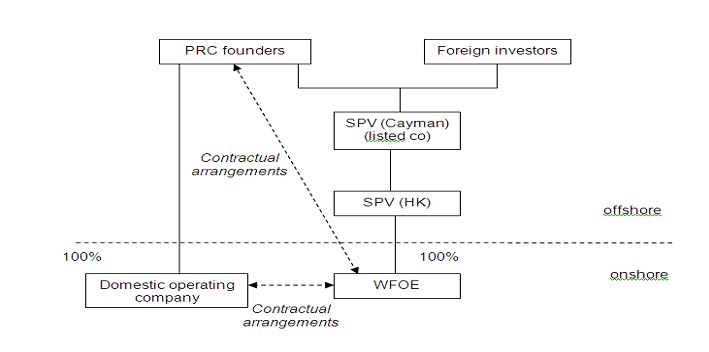
Typical contents of contractual arrangements between domestic company and the WFOE
- Exclusive Service Agreement
- The WFOE provides exclusive consultancy, management and technology services to the domestic company in return for a fee shifting profit from domestic company to the WFOE
- Call Option Agreement
- The WFOE is granted the option to acquire all or portion of the equity interest of the domestic company at the lowest permitted price
- Equity Pledge Agreement
- The domestic shareholder will enter a registered pledge for all its equity interests in favour of the WFOE to secure due performance of the contractual obligations
- Loan Agreement
- The WFOE will grant a loan to the domestic shareholder for capitalising the domestic company
- Voting rights agreement / Power of attorney
- The domestic shareholder irrevocably grants the WFOE all its shareholder rights (incl. voting rights)
Why VIE?
- Major reasons for adopting the VIE structure:
- Allow foreign investors to enjoy economic benefits of engaging in businesses sectors classified as “restricted” for foreign investment
- Enable round-trip investment without triggering Article 11 of the M & A Rules which requires approval from Central MOFCOM whenever Chinese companies or individuals acquire an affiliated company in China via a controlled offshore company
VIE Structure Risks
- Regulatory risk of structure being declared invalid by PRC authorities
- Risk that contractual arrangements will be unenforceable or insufficient to retain control over VIE
- g. The notice on value added telecommunication service by foreign investors, The notice of general administration of press and publication
Regulatory risks
- The measures on security review system of M & A of Chinese enterprises by foreign investors (Sept 2011)
- Foreign investors are prohibited from adopting various forms of indirect control of domestic entities so as to avoid national security review
- Public policy – Buddha Steel was required to withdraw its listing application
- The withdrawal might be more an indicator that the regulatory authorities are tightening control on foreign investment in certain core industries than a disapproval of VIE structure
- An internal CSRC report disclosed in Sept 2011 (apparently advocating prior MOFCOM approval of VIE structures)
- Raised concerns about national security (particularly regarding internet industry and asset-heavy industries)
- Desirability of PRC companies in emerging industries listing onshore
- Possible negative impact of prohibiting VIE structures addressed e.g. restriction of fund raising activities by companies unable to list on domestic exchanges
- No official confirmation on the genuineness of the report
Recent approval by MOFCOM
- MOFCOM approved the acquisition of Niu Hai (Yihaodian) by Wal-Mart
- To safeguard the restricted area of business, MOFCOM imposed the following conditions:
- The acquisition should be confined to the direct sales business
- Without prior approval for engaging in VATS business, Niu Hai should not provide internet services to other parties
- Wal-Mart is not allowed to use VIE to engage in VATS business currently operated by Yihaodian
- The most direct reference to VIE by Chinese authorities so far
- However, the decision is not an indicator of any policy changes towards VIE structure
Recent views of the HKSE: Listing Decision 43-3 revised in August 2012
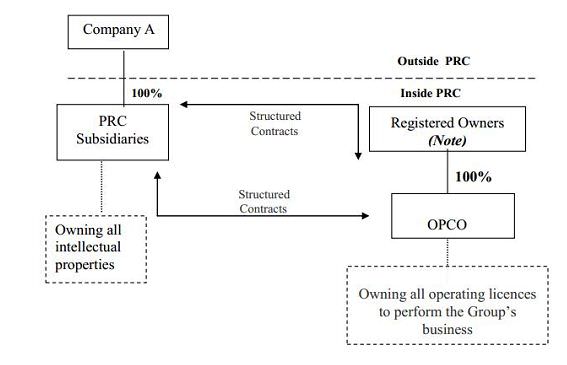
The Registered Owners were controlling shareholders of Company A
- A disclosure-based approach will be adopted in considering listing applications involving VIE
- HKSE will not consider an applicant unsuitable for listing if all relevant PRC laws and regulations have been complied with
- Appropriate regulatory assurance should be obtained from the relevant regulatory authorities
- Without regulatory assurance, the applicant’s legal counsel will be required to make a statement to the effect that all possible actions or steps have been taken
- Requirements for an applicant using VIE and its sponsor:
- Provide reasons for the use of structured contracts in its business operation
- Unwind the structured contracts as soon as the law allows the business to be operated without them
- Ensure the structured contracts encompass dealing with the assets of the domestic company, not only the right to manage and the right to revenue
- Ensure the structured contracts contain:
- a power of attorney granted by the domestic shareholder to the applicant’s directors giving them the power to exercise all rights of the domestic shareholder
- Dispute resolution clauses providing:
- for arbitration and that remedies over the shares, land or assets, njunctive relief or winding up order of the domestic operating company may be awarded
- the courts of competent jurisdictions (HK, the applicant’s place of incorporation, the place of incorporation of the domestic company, the location of the domestic company’s principal assets) with the power to grant interim remedies in support of the arbitration pending formation of the arbitral tribunal
- for provisions that grant the right to dispose of the assets of the restricted business (in case of liquidation)
- For the first time, the Exchange made it clear that if VIE structures are adopted in non-restricted business areas, the Listing Division of the Exchange will normally refer the case to the Listing Committee to determine suitability for listing
- Prospectus disclosure requirements:
- detailed discussion about the restricted business’ registered shareholders and a confirmation that appropriate arrangements have been made to protect the applicant’s interests;
- arrangements to address the potential conflicts of interest between the applicant and the registered shareholders;
- Reason why the directors believe that each of the contractual arrangements is enforceable under PRC and local law;
- The economic risks the applicant bears as the primary beneficiary of the restricted business;
- Whether the applicant has encountered any interference from any PRC governing bodies
- The limitations in exercising the option to acquire ownership in the restricted business with a separate risk factor explaining the limitations
- The contracts forming the Contractual Arrangements must be included as material contracts in the “Statutory and General Information” section and must be available on the applicant’s website;
- The corporate structure table in the “Summary” section must be included;
- “Risk Factors” section:
- The PRC government may determine that the VIEs do not comply with applicable regulations;
- The VIEs may not provide control as effective as direct ownership;
- The domestic shareholders may have potential conflicts of interest with the applicant; and
- VIEs may be subject to scrutiny by the PRC tax authorities and additional tax may be imposed.
CHINA’S OUTWARD DIRECT INVESTMENT
China ODI trend
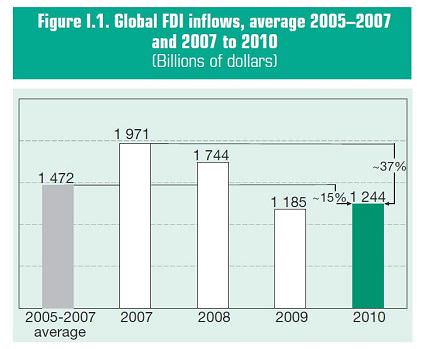
Source: UNCTAD, based on annex table l.1 and the FDI/TNC database (www.unctad.org/fdistatistics).
Graph 1: Outward FDI flows of China and other major home economics, 2010
(Billions of USD)
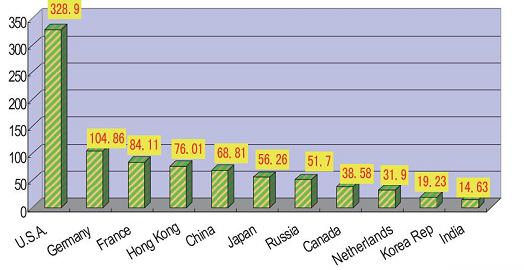
Source: 2010 Statistical Bulletin of China’s Outward Foreign Direct Investment
Graph 2: Outward FDI stock of China and other major home economics, 2010 (Billions of USD)
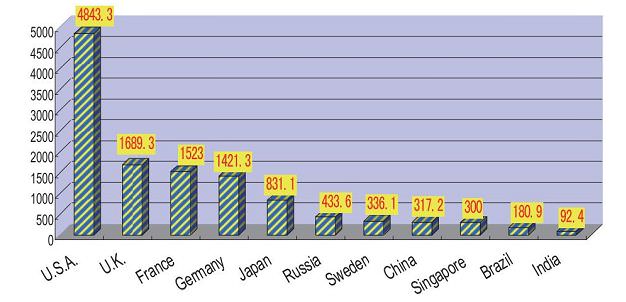
Source: 2010 Statistical Bulletin of China’s Outward Foreign Direct Investment
- Directly invested in 2,169 overseas companies in 117 countries and regions
- Hired more than 1.1 million of workers, of which 0.8 million are foreign employees
- From 2003 to 2011, 172 greenfield projects in the US with total value of more than USD$7 billion
- Created 44,000 jobs in the US
Sectoral composition (stock) by 2010
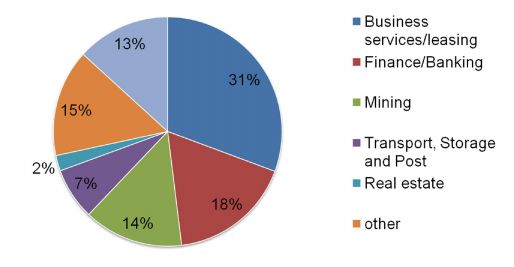
Source: 2010 Statistical Bulletin of China’s Outward Foreign Direct Investment
- Chinese outbound M&A reached new record in 2011
- 207 deals (up 10% from 2010) raised US$42.9bn (up 12% from 2010)
- 16 outbound M&A deals in 2011 had a value > US$1bn – 14 of these in the resources and energy sector
- Increasing focus on consumer and industrial products industries reflecting gradual shift to consumer driven economy
- Contrast: Foreign inbound M&A in 2011 dropped 11% to 482 deals
- Domestic M&A activity in 2011 increased by 11% with 3,262 deals
China ODI trend – reasons for upward trend
- Huge trade surplus savings and foreign exchange reserves
- Shortages in raw materials, mineral resources, export markets and advanced technology
- Support of the Chinese government:
- Low cost finance offered by state-owned banks
- Approval requirements
- Foreign currency control
- “Round-tripping” investment
Regulatory framework for ODI
- Quasi tri-partite system:
- Ministry of Commerce (MOFCOM)
中華人民共和國商務部
- National Development and Reform Commission (NDRC)
國家發展和改革委員會
- State Administration of Foreign Exchange (SAFE)
國家外匯管理局
- Ministry of Commerce (MOFCOM)
Regulatory framework for ODI – MOFCOM
- Administration Measures on Outbound Investment
境外投資管理辦法
- Oversees acquisition of overseas equity/assets, controlling/management rights or establish overseas branches
- Particular focus on structure of JV contracts and constitutional documents
| Types of ODI | |
| Provincial MOFCOM approval (Article 7) |
|
| Central MOFCOM approval (Article 6) |
|
The length of time for getting approval at provincial level is generally shorter than that at central level
- ODI that triggers automatic disapproval
- Endanger state sovereignty
- Damage PRC’s foreign relations with the host countries
- Breach any international treaty entered into by the PRC
- Involve goods and technologies prohibited for import
- MOFCOM with SAFE will conduct annual inspections of overseas companies established by Chinese investors from 1 June to 31 July each year
- Effect of the Administration Measures:
- 85% of applications will be handled by provincial MOFCOM
- Most ODI applications could obtain approval within 3 working days
- Application materials for ODI above USD$10 million:
- An application (with overseas company’s name, registered capital, amount of investment, business scope, operation period, explanation of the source of invested funds, specific content of investment, shareholding structure, investment environment analysis and evaluation and assurance that the ODI does not meet any rejection conditions)
- Copies of business licences of the domestic company
- Articles of association and constitution documents of the overseas company
- Approval or filing documents issued by relevant authorities
- Preliminary report on overseas merger and acquisition
- Other documents required
Regulatory framework for ODI – NDRC
- Tentative Measures for Administration of the Approval of Outbound Investment Projects
境外投資項目核准管理辦法
- A consultation is launched to simplify the current procedure and to increase NDRC’s authority
- Significant overlaps with MOFCOM and SAFE in the past
- In practice, Chinese ODI tend to first seek NDRC’s approval
- MOFCOM’s approval is seen as procedural
Scope of investments:
NDRC approval at the central level is required for the following investments:
- in resources development with a value above USD$300 million;
- in any industry if the value of the investment exceeds USD$100 million;
- in sensitive industries such as telecommunications; and
- in countries without diplomatic relations with the PRC;
- Any other investments are subject to NDRC’s approval at provincial level.
The Proposal:
- Investments in transportation and infrastructure industries are proposed to be regarded as resources development investments;
- Investments in transportation and infrastructure industries and resources development, with a value of more than USD$300 million, would be subject to central NDRC approval;
- If the investment value is below USD$300 million, the investment would be subject to provincial NDRC approval only
Funding of investments:
Overseas subsidiaries:
- Currently all outbound investments by entities incorporated in the PRC and/or investments through their overseas subsidiaries require NDRC approval
The Proposal:
- NDRC approval would no longer be required for outbound investments made through overseas subsidiaries which are not supported by domestic financing or guarantees given by the PRC parent
Overseas bids and acquisitions:
NDRC’s confirmation prior to submitting bids:
- Chinese enterprises are required to secure a confirmation letter from it prior to submitting a bid, executing a binding agreement or filing an application with any relevant regulatory or governmental body with jurisdiction over the target company
The Proposal:
- The requirement is limited to bids or acquisitions with a value of more than USD$100 million
Further approval:
Reporting requirements in case of substantial changes:
- Change of scale, products and major terms of investments;
- Change of investment location; and
- More than a 20% increase in the original investment amount.
The Proposal:
- change of shareholding of the investor;
- change in the form of cooperation of a joint enterprise investor;
- change to the terms of a merger, acquisition and equity participation;
- only substantial changes occurring within the implementation period will require central NDRC approval;
- the approval requirement for post-completion sale of shares or assets in the investment is removed.
Regulatory framework for ODI – SAFE
- Registration with SAFE after approval by MOFCOM and NDRC
- Without SAFE registration, no remittance of foreign exchange from China allowed
- An explanatory statement of the source of funds has to be submitted
- SAFE registration needed for opening overseas account
- General rule:
- All profits and income from overseas investment must be remitted back to China within 6 months of the end of overseas FY, or within 30 days of completion of a transfer of overseas investment
- Trial reform:
- 14 provinces and cities (Zhejiang, Jiangsu, Shanghai, Shandong and Guangdong included)
- Chinese investors based in such trial reform cities are exempt from profit remittance requirement
- Instead, the profit may be used for offshore re-investment or capital accumulation
- Investors are also allowed to use foreign currency loans, policy loans or purchase foreign currency without quota
Regulatory framework for ODI – Taxation
- Enterprise Income Tax
- PRC tax resident: a company legally established in China or foreign company with effective management located within the PRC
- Such PRC tax resident is taxed on its worldwide income derived from sources both inside and outside of the PRC
Case Study
- Geely’s acquisition of 100% Volvo in Aug 2010 from Ford
- Consideration: USD$1.8 billion
- Geely’s benefits:
- Cheaper assembly of Volvo cars in China
- Exploit China’s luxury car market with Volvo’s brand
- More sales and bigger margins
- Access to technology
- CIC’s acquisition of 15% AES in Nov 2009
- Consideration: 125.5 million of shares for USD$12.60 per share
- To raise USD$1.58 billion to fund growth opportunities
- Signed a LOI to raise USD$571 million for wind power generation business
Recent successful investments by Chinese companies (deal size > US$1bn)
| Date | Company | Industry | Assets | Deal size (USD billion) | Country |
| Jun 2011 | Heilongjiang Beidahuang Nongken | Agriculture | China’s largest farming company, Heilongjiang Beldahuang Nongken invested $1.5bn to lease and develop farms on 300,000 hectares in Argentina’s Rio Negro Province | 1.5 | Argentina |
| Jun 2011 | Anhui Conch Cement | Construction | To invest and launch four new plants in Indonesia | 2.4 | Indonesia |
| May 2011 | Shangdong Iron | Metals | Acquired 25% stake in African Minerals’ Tonkolili iron ore project in Sierra Leone | 1.5 | Sierra Leone |
| Apr 2011 | Datang Power and Baoding Tianwei | Energy | Established a joint venture with Australia’s CBD Energy to develop wind farms and other renewable resources in Australia. Datang Power holds 63.75% stakes in the joint venture while Baoding Tianwei holds 12.5% | 2.0 | Australia |
| Mar 2011 | Sinopec | Energy | Partnered with SABC to develop Yanbu Export Refinery. Sinopec holds 37.5% stake in the project. | 3.8 | Saudi Arabia |
| Mar 2011 | Chongqing Grain | Agriculture | To launch an agri-industrial project in the state of Bahia, Brazil | 2.4 | Brazil |
| Mar 2011 | CNOOC | Energy | Purchase a one-third interest in three exploration areas in UK-based Tullow Oil pic | 1.5 | Uganda |
| Feb 2011 | Sinopec | Energy | Acquired 15% stake in the Australia Pacific liquefied natural gas (LNG) project | 1.5 | Australia |
| Feb 2011 | Wanhua Industrial | Chemicals | Purchase 96% stake in BorsodChem, a Hungarian chemical company | 1.7 | Hungary |
| Jan 2011 | Ashima Cultural Group | Construction | To build a ‘commercial city’ in Thailand and the construction is expected to be completed by 2013 | 1.5 | Thailand |
| Jan 2011 | ChemChina | Metals | Blue Star, controlled by Chemchina, acquired the silicon business of Norwegian conglomerate Orkla | 2.0 | Norway |
Source: China Daily, China Economic Review, Financial Times, Reuters, The Heritage Foundation
Recent major Chinese investments rejected
| Date | Company | Industry | Assets | Reasons of failure |
| Jun 2011 | PetroChina | Energy | Encana agreed to sell to PetroChina a 50% stake in an area of shale-and deep-gas assets in northeastern British Columbia and northwestern Alberta for 5.4 billion Canadian dollars | Failed to agree on terms |
| May 2011 | Guangdong Nuclear | Energy and Mining | Takeover of Kalahari Minerals with an offer of 270p per share (-US$1200m) | UK Takeover Panel blocked its attempt proceed |
| Aug 2010 | Huawei Technologies | Telecommunication | Motorola’s mobile network infrastructure unit (US$1300m) | Questions over Huawei’s ability to win regulatory approval |
| Jul 2010 | Huawei Technologies | Telecommunication | Takeover of 2Wire, US-based maker of broadband internet software (US$480m) | |
| Apr 2010 | Bright Food | Food | An informal A$1.5 billion bid for the sugar and renewable energy business of Australian industrial company CSR. The friendly bid was rejected because, as CSR directors said, they were only interested in a deal that had a “sufficiently high degree of certainty as to value, timing and likelihood of completion” | Failed to agree on terms |
| Feb 2010 | Huawei Technologies | Telecommunication | A U.S. government panel told Huawei to divest technology assets bought from 3Leaf Systems | US security concerns |
| Dec 2009 | Sinochem | Energy | A$2.8 billion bid for agrichemicals producer Nufarm was trumped by Japan’s Sumitomo | Failed to agree on terms |
Source: Financial Times
Investment environment: the US
- Committee on Foreign Investment in the United States (CFIUS)
- Power to block acquisitions that would impair US national security
- Rejected cases:
- China National Offshore Oil corporation takeover bid for Unocal Corporation (2005)
- Huawei Technologies and Bain Capital acquisition of 3Com Corporation (2008)
- Criticism: lack of predictability; possible abuse for economic protectionism
- More scrutiny for “foreign government controlled transactions” à China state-owned or state-financed investors inc. sovereign wealth funds
- Especially cautious of infrastructure acquisition
- Possible extension of review period for 45 days beyond the normal 30 days period
- Mitigation measures may be required e.g.:
- Enter a national security agreement with a CFIUS agency
- Letter of assurance to CFIUS
- Non-exhaustive list of businesses attracting CFIUS review:
- Government contractors providing products/services to state or federal government
- Non-government contractors providing national security products/services to US government
- Critical infrastructure
- Advanced technology
- Goods or services subject to export control
- Advice from CFIUS:
- Anticipate that acquisition falling into sensitive areas will attract CFIUS review
- Anticipate that acquisition of businesses with contracts with the US government / with products or services subject to export control will attract CFIUS review
- Demonstrate acquirer’s independence from the government in terms of management and investment decisions
- Be ready to accommodate CFIUS request on mitigation measures
- Engage legal advisors and public relations advisors
Investment environment: Europe
Transactions subject to competition review and European Commission consent
| Effects of the proposed M & A | |
| Test 1 |
Combined worldwide turnover exceeds EURO 5,000 million AND EU wide turnover of each of at least 2 parties exceeds EURO 250 million unless more than 2/3 of the EU wide turnover of each party arises in the same member state OR |
| Test 2 |
Combined worldwide turnover of the parties exceeds EURO 2,500 million AND EU wide turnover of each of at least 2 parties exceeds EURO 100 million AND In each of at least 3 member states the combined turnover of the parties exceeds EURO 100 million AND In each of the 3 member states, the turnover of each of at least 2 parties exceeds EURO 25 million, unless more than 2/3 of the EU wide turnover of each party arises in the same member state |
UPDATE ON GLOBAL IPO & CHINA IPO ACTIVITIES
- Fall in domestic market capitalisation of the world’s 10 largest stock markets in 2011
- Due to high volatility and global uncertainty created by factors like sovereign debt crisis
- Sharp decrease of global market capitalization (-13.6% to USD 47 tn)
- Domestic market capitalization declined back to same levels as at end 2009
- Shanghai SE and HKSE were ranked the 6th and 7th largest stock exchanges
Domestic market capitalisation of stock exchanges worldwide in 2011
| Exchange | USD bn | USD bn | % change | % change | |
| end-2011 | end-2010 | in USD | in local currency | ||
| 1 | NYSE Euronext (US) | 11,796 | 13,394 | -11.9% | -11.9% |
| 2 | NASDAQ OMX (US) | 3,845 | 3,889 | -1.1% | -1.1% |
| 3 | Tokyo Stock Exchange Group | 3,325 | 3,828 | -13.1% | -17.6% |
| 4 | London Stock Exchange Group | 3,266 | 3,613 | -9.6% | -6.6% |
| 5 | NYSE Euronext (Europe) | 2,447 | 2,930 | -16.5% | -13.7% |
| 6 | Shanghai Stock Exchange | 2,357 | 2,716 | -13.2% | -17.1% |
| 7 | Hong Kong Exchanges | 2,258 | 2,711 | -16.7% | -16.8% |
| 8 | TMX Group | 1,912 | 2,170 | -11.9% | -9.7% |
| 9 | BM&FBOVESPA | 1,229 | 1,546 | -20.5% | -10.7% |
| 10 | Australian Securities Exchange | 1,198 | 1,454 | -17.6% | -17.6% |
Source: World Federation of Exchanges Statistics
Global IPO activities
- total listings among WFE members increased slightly by 1.7% with 45,953 companies listed
- US$203bn raised through IPO by WFE members in 2011 (-41% comparing 2010 at US$ 343bn)
- g. Funds raised through IPO by NYSE Euronext (US) dropped 15% from US$33bn in 2010 to US$28bn
- Hong Kong as the largest IPO market of 2009, 2010, 2011 in terms of IPO funds raised
- Shenzhen ranked 3rd and Shanghai ranked 6th
- Financial power shifting from the west to the east
Total IPO equity funds raised in 2011
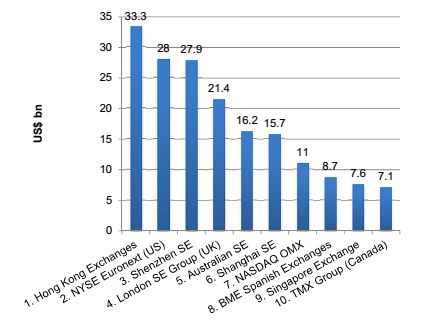
Source: World Federation of Exchange Statistics, HKEx
| Stock Exchange | Number of Newly Listed Companies | Funds Raised (US$bn) |
| Hong Kong | 101 | 33.3 |
| Shanghai | 38 | 15.7 |
| Shenzhen | 243 | 27.9 |
Source: World Federation of Exchanges Statistics
Chinese IPO activities
- For both 2010 and 2011, Hong Kong, Shanghai & Shenzhen accounted for 38% of global IPO funds raised
- Dual listing of Agricultural Bank of China Ltd on the Shanghai and Hong Kong Stock Exchanges in 2010
- Largest IPO worldwide ever
- Raised US$22.1 billion
Mainland Enterprises (Main Board and GEM)
| End 2011 | End 2010 | |
| No. of H shares | 168 | 163 |
| No. of Red chips Stocks | 107 | 102 |
| No. of NHMPE | 365 | 327 |
| Market capitalization (% of market total) | 55.3% | 57% |
| Turnover value (% of total equity turnover) | 66% | 68% |
NHMPE = Non-H Share Mainland Private Enterprises
Source: the Hong Kong Exchange
| Exchange | No. of listed companies at 31.12.2011 |
| Shanghai Main Board | 931 |
| Shenzhen Main Baord | 472 |
| Shenzhen SME Board | 646 |
| Shenzhen ChiNext* | 281 |
*93% of companies listed on ChiNext at 31.12.2011 were hi-tech firms
Source: the Shanghai and Shenzhen Exchanges
TREND OF CHINESE IPO ACTIVITIES IN 2011
Globalisation capital market
- Numerous cross-border listings
- Non-Asian companies began to make primary listing in Hong Kong
- Higher valuations and strong liquidity
- Example: Russia’s RUSAL, Brazil’s Vale, Italy’s Prada
- 41 Chinese companies listed on US exchanges as well
- Growing importance of China’s economy

IPO market cools down after 2010
- Due to the European sovereign crisis, the US debt ceiling discussions and concerns over economic growth in China
- of IPO of Shanghai and Shenzhen ↓ 19%, funds raised ↓ 41%
- of IPO of Hong Kong decreased ↓ 11%, funds raised ↓ 42%
- 27% of newly-listed companies in Shanghai & Shenzhen traded underwater
- Companies pulled or postponed IPOs
- Issuers’ unwillingness to drop pricing to accommodate poorer sentiment and higher risk aversion
- Investors restrained by Chinese inflationary concerns over commodity prices and housing prices
- Chinese IPO pipeline remains strong, comprising large state owned enterprise, and mid-cap companies
International Board of Shanghai Stock Exchange (SSE)
- Shanghai Stock Exchange (“SSE”) been preparing for launch of an international board for over 4 years
- International board would allow Chinese investors to invest directly in foreign companies and foreign companies to raise capital in RMB
- During 2011 – strong hints that central authorities ready to approve international board
- January 2012 – Shanghai Mayor Han Zhen – said timing is not right for launch of the international board and Shanghai would start an over-the-counter exchange soon
- Challenges to the International Board
- Foreign Exchange
- Coordinating the relationship with the Hong Kong Stock Exchange
- Coordinating with the International Securities Exchange and Accounting Systems
- China’s State Administration of Taxation issued Circular 348, which aims to clarify the tax treatment for dividends paid to foreign individual shareholders by Chinese enterprises listed in Hong Kong
- Circular 348 came into effect on 28 June 2011
- Individual shareholders who are HK residents subject to withholding rate of 10% on H share dividends under China/Hong Kong tax agreement
- Individual shareholders resident in other countries which have tax agreements with China providing for withholding rates higher or lower than 10% should pay tax accordingly
- Individual shareholders resident in a country that does not have a tax agreement with China are subject to a withholding tax rate of 20%
- CSRC to simplify the approval procedure for companies seeking IPOs in HK or offshore markets
- The existing procedure is known for its lack of transparency and predictability
- A waiver of the preliminary reviews by CSRC is desired by companies seeking listing in HK
NEW RULES ON BACKDOOR LISTING AND ASSET ACQUISITION
- Amendments to the Administrative Measures for the Restructuring of Material Assets of Listed Companies (the “Measures”)
上市公司重大資產重組管理辦法
- Effective on 1 September 2011
New Rules on Backdoor Listing
- Key changes:
- Backdoor listing threshold raised closer to that for IPOs
- More transparent rules for asset acquisition by listed companies
- Improved regulations for asset acquisition by way of share issue
- Backdoor listing:
- A privately held company becomes listed by way of acquisition of an existing listed company (otherwise known as “shell company”)
- Also known as reverse takeover / reverse merger
- Advantages:
- Increased speed of listing
- Certainty of outcome
- Less dilution effect
- Greater control for the new owners
- The ability to circumvent onerous requirements for new listing (in some jurisdictions)
- Problems with the old rules:
- Backdoor listings face significantly less stringent rules than IPOs
- Possibility of insider trading
- Possibility of accounting fraud
- Aims of the new rules:
- Closer supervision of poorly performing companies
- Reduced insider dealing and accounting fraud
- Particulars of the Measures
- Statutory definition of backdoor listing (Article 12):
the value of a private company’s total assets acquired by a listed company from a person or entity that has acquired control of the listed company, equals or exceeds the value of the listed company’s total assets, as shown in its audited consolidated financial statements at the end of the most recent fiscal year
- Requirements on the private company (Article 12):
- Minimum 3 consecutive years of trading record
- Positive net profit for each of the last 2 FY
- Net aggregate profit of RMB 20 million for last 2 FY
- Statutory definition of backdoor listing (Article 12):
- Particulars of the Measures
- Measures to tackle accounting fraud (Article 35)
- Minimum period for continuous supervision and guidance from independent financial consultant increased to 3 FY
- Minimum supervision period for listed companies having undergone other material asset restructurings remains 1 FY
- Measures to tackle accounting fraud (Article 35)
- Advantages of backdoor listing despite the changes:
- Net profit requirements still lower than for IPOs
- No cash flow, net asset or share capital requirements as there are for IPOs
- Shorter time than IPOs
Comparison of Listing Requirements between IPOs and Backdoor Listing
| Regulations | Business Operation Requirement | Profit Requirement | Other requirement | |
| IPOs on main board or SME board | Administrative Measures for the IPO and Listing of Stocks | 3 yrs | Profits record for each of last 3 yrs AND being not less than RMB 30 million in aggregate |
|
| IPOs on ChiNext | Interim Measures for the Administration of IPO and Listings on the ChiNext | 3 yrs |
Profit record for each of last 2 yrs AND being not less than RMB 10 million in aggregate OR Profit record in most recent yr not less than RMB 5 million plus revenues being not less than RMB 50 million, the revenue growth rate of past 2 yrs being not less than 30% |
|
| Backdoor listing | Administrative Measures for the Restructuring of Material Assets by listed Companies | 3 yrs | The private company must have profit recorded for each of last 2 yrs AND being not less than RMB 20 million in aggregate | No requirements as to minimum cashflow, net assets or share capital |
New Rules on Asset Acquisition by way of Share Issue
- Target of the Measures (Article 42):
- Acquisitions of assets by listed companies by way of share issue to parties other than the controlling shareholders / actual controllers or other parties controlled by them (“Independent Parties”)
- Purpose: make the existing regulatory regime more comprehensive, more cost effective and more efficient
- Requirements of acquisition by way of share issue:
- The aim of asset acquisition should be industrial consolidation and synergy with the listed company’s main business
- The share issue must not result in a change in control of the listed company
- The share issue must comprise at least 5% of the listed company’s total issued share capital after the share issue
- Otherwise, the transaction price must be at least RMB 100 million for Main Board / SME company OR RMB 50 million for ChiNext company
- Article 43: encourage listed companies to finance merger and acquisitions by way of share, bond or convertible bond issue
- Previously, asset purchase and financing for asset purchase by way of share issue required two separate approvals
- Under the new Article 43, they are merged into one approval process
OVER-THE-COUNTER TRADING (“OTC”)
OTC Markets
- China’s third OTC market launched in Shanghai on 15 Feb 2012 after Tianjin and Chongqing
- Shanghai Equity Exchange (SEE)
- 19 start-up companies have started trading their shares
- Mainly in technology / niche sectors
- A stepping stone to future listing on the major exchanges
- No national laws/regulations on OTC markets yet
- Securities Law Article 39: securities publicly issued must be listed on an exchange or any other places for securities trading as approved by the State Council
- Company Law Article 139: transfer of shares must be conducted on an exchange or by any other means as prescribed by the State Council
- Problems for China’s OTC markets:
- Inadequate regulatory regime
- Difficulty in attracting investors and boosting trade volumes
- Lukewarm trading in SEE
- Absence of regulations commonly found in other OTC markets
RMB INTERNATIONALISATION
History of RMB Quasi-internationalisation
| Time | Events |
| Dec 2002 | PBOC launched “QFII” which allows foreign investors to trade RMB denominated “A” shares in China exchanges |
| 2003 | HK residents permitted to buy RMB up to a daily limit |
| Feb 2004 | HK became offshore RMB clearing centre; RMB personal businesses allowed in HK |
| April 2006 | PBOC launched “QDII” which allows mainland institutions to invest in offshore markets such as securities and bonds |
| Jul 2007 | First RMB bond issues outside China |
| Dec 2008 | Currency Swap Agreement with 6 countries worth US 95.5 billion |
| Jul 2009 | Pilot enterprises are allowed to settle trade with overseas enterprises in RMB |
| Sept 2009 | China issued first RMB government bond in HK |
| Jun 2010 | China expanded the RMB trade settlement pilot scheme |
| Jul 2010 | PBOC introduced a pilot scheme for banks to access the mainland RMB interbank bond markets |
| Aug 2010 | McDonald’s became the first foreign non-financial firm to issue RMB bonds outside China |
| Sept 2010 | Supranational institutions were allowed to issue bonds in the PRC and use the proceeds outside China |
| Oct 2010 | HKMA relaxed the selling and distribution restrictions on the distribution of RMB investment products |
| As of 2010 | There were 22 QFII institutions approved with total investment of USD 3.05 billion and 19 QDII institutions approved with total investment of USD 7.017 billion |
| Jan 2011 | PBCO launched pilot program to allow qualified domestic firms to use CNY for outward direct investments |
| Aug 2011 | China issues RMB 20 billion of government dimsum bonds, the biggest ever offshore RMB bond issuance |
| Oct 2011 | China allowed offshore-raised RMB to be used for FDI into China |
| Nov 2011 | PBOC and the HKMA doubled the size of bilateral currency swap agreement to RMB400 billion |
| Dec 2011 | HK subsidiaries of qualified fund managers and securities companies were allowed to channel RMB raised in HK to invest in Mainland securities markets (RQFII) |
| Jan 2012 | Hong Kong announced its strategic link with London to develop offshore RMB business |
| Feb 2012 | It is rumoured that Chinese financial regulators have decided in principle to allow global hedge funds to raise capital on the mainland |
| Mar 2012 | PBCO allowed trading entities all over the world to settle trade in RMB subject to local restrictions |
| Mar 2012 | The China Development Bank agreed to extend credit in RMB to BRIC countries |
| Apr 2012 | The CSRC, the State Council, the PBOC and the SAFE allowed a second batch of RQFII quotas worth 50 billion RMB |
| May 2012 | The NDRC issued a circular stipulating the regulatory framework for onshore PRC non-financial institutions to issue RMB bonds in HK |
| As of Sept 2012 | Argentina (RMB150 billion), Australia (RMB200 billion), Belarus (RMB20 billion), Hong Kong (RMB400 billion), Iceland (RMB3.5 billion), Indonesia (RMB100 billion), Kazakhstan (RMB7 billion), New Zealand (RMB25 billion), Pakistan (RMB10 billion), Singapore (RMB150 billion), South Korea (RMB360 billion), Thailand (RMB70 billion), Turkey (RMB10 billion), and Uzbekistan (RMB700 billion) |
The roadmap to full internationalisation
- Make the RMB an international trade settlement currency
- Turn the RMB into an investment currency by allowing two-way flows of the RMB
- Turn the RMB into an international reserve currency
- Ideally, internationalising the RMB with minimal turbulence in the onshore market
Internationalisation and capital controls
- Internationalisation: market participants from all over the world use RMB
- Capital controls: constrain the market force on RMB through restrictions on withdrawals and deposits so as to maintain a fixed exchange rate for the RMB
- China has begun RMB internationalisation without liberalising its capital account
- As RMB is being more freely traded in the market, the market has created a huge pressure on the fixed exchange rate
- How can the Chinese government continue to pursue internationalisation within the regime of capital controls?
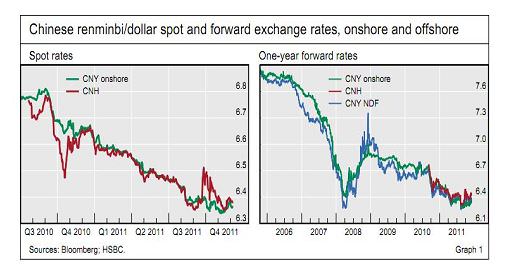
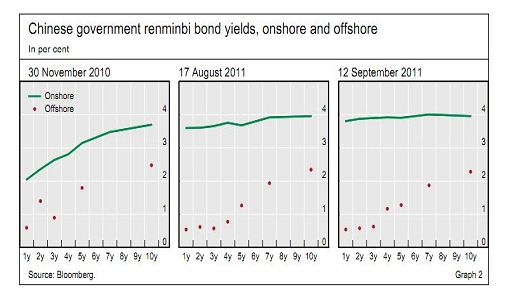
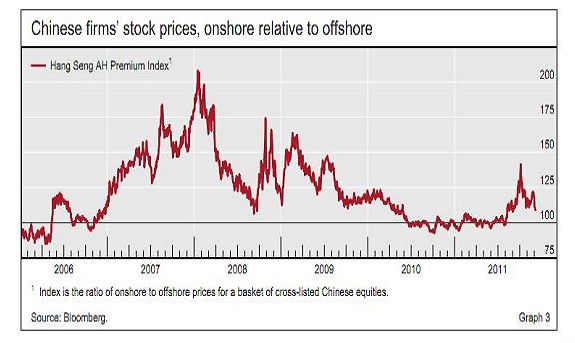
The Risks of RMB internationalisation
- Currency speculation
- Short-term economic shock as exports drop
- Could the 7 new industries catch-up in time?
- Economic as well as political
- Capital mobility + Fixed exchange rate system = Loss of monetary autonomy in macro-economy
Challenges to China with internationalisation
- 1. Monetary policy options restricted
Impossible Trinity
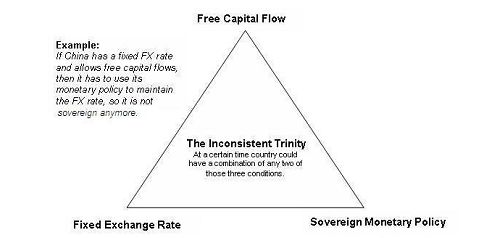
- RMB exchange rate policy might be restricted
- Depreciation policy to boost export no longer available as this would hurt RMB reliability and credibility
- International liquidity vs. exchange rate stability
Latest Movement
- RMB deposits hit record high but shrank again
- As of March 2012, RMB deposits reached 672.4 billion
- As of July 2012, RMB deposits fell to 563 billion, probably due to a weaker RMB against the dollar
Some updates on the future of Dim Sum Bonds
- Popularity of Dim Sum Bonds – Can it be sustained?
- Weak export growth, stronger dollar and diminished inflation weaken RMB appreciation expectation
- NDF market suggests slight appreciation
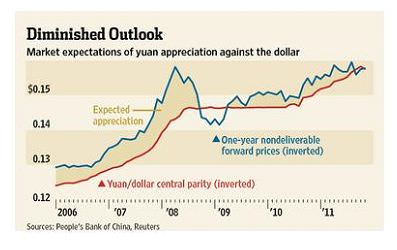
- Demand for higher yields on Dim Sum Bonds
- By the end of 2011, RMB bond issuance amounted to RMB 107.9 billion
RQFII
- RMB Qualified Foreign Institutional Investors (RQFII)
- effectively an RMB-settled version of the pre-existing QFII scheme
- Hong Kong subsidiaries of fund management companies and securities firms incorporated in Mainland China can use RMB raised in HK to invest in mainland securities market within a permitted quota
- Regulatory framework:
- CSRC: regulates onshore securities investment by an RQFII, reviews applicants’ eligibility and issues RQFII licences.
- PBOC: regulates onshore RMB accounts opened by an RQFII, regulates investment by RQFII in the money markets and monitors the remittances of RMB funds
- SAFE: allocates and regulates the use of investment quota under the RQFII scheme, and monitors the remittances of RMB funds jointly with PBOC
- Requirements & Eligibility:
- engage a qualified onshore commercial bank as custodian
- onshore securities companies as brokers for securities trading
- MAY engage Mainland China fund management companies or securities companies to manage onshore securities investment portfolio
- Requirements & Eligibility:
- must have a Type 9 license (asset management) from SFC
- financially stable with a satisfactory credit standing
- effective corporate governance and internal control procedures
- necessary professional qualifications as required in Hong Kong
- have not been subject to any material punishment by local regulatory agencies during the three years prior to the application
- other conditions as CSRC may stipulate in accordance with the principle of prudential regulation
- Difference from QFII:
- only a RQFII may invest in the inter-bank bond market in accordance with PBOC rules
- Approval:
- CSRC will approve or decline applications within 60 days after reviewing complete set of application documents
- On approval, CSRC will grant RQFII licence
- Upon receiving the licence, the HK subsidiary must apply to SAFE for an investment quota within one year
- SAFE will determine whether to grant the applied quota within 60 days
- Quota:
- Total aggregate investment quota: 70 billion RMB
- Monitor & Control
- A RQFII must remit RMB funds through its qualified onshore custodian
- The custodian is obliged to supervise the onshore investment made by the RQFII
- Investment
- no less than 80% of the fund in fixed-income securities
- no more than 20% investment in stocks and equity funds
- As of April 2011, 16 securities firms and 9 fund management companies had Hong Kong subsidiaries
- Up to 23 December 2011, 9 fund management companies first obtained the RQFII approvals from CSRC
- In April 2012, a second batch of RQFII quotas of 50 billion RMB was allowed
- the new RQFII participants will be allowed to issue RMB denominated A-share ETF RQFII products accessing A-share index constituent stocks
- ChinaAMC, Harvest, E Fund and China Southern, have reportedly submitted their applications to the SFC for RQFII quotas
London Link
- London to become next offshore RMB center
- Extend real time HK’s settlement system to 15 hours per-day overlap the European market
- Study group formed of private sector will be set up
- Complementary or Competitive?
NDRC Circular – issuance of RMB bonds in offshore markets by non-financial enterprises
- Issued on 2 May 2012
- To formalise the approval process and establish the regulatory framework for onshore PRC non-financial institutions to issue RMB bonds in Hong Kong
- Previously, approvals granted on a discretionary basis
- Baosteel Group Corporation, China Minmetals, Guangdong Nuclear Power, Huaneng Power and Datang Power etc
- It is likely that state-owned enterprises will be given preference
Application procedure
- Enterprise supervised by the central government → submit application to the NDRC
- Enterprise supervised by the provincial branch of the NDRC → submit application to the provincial branch → final approval lies with central NDRC
- Time limit for approval:
- Within 60 working days of accepting the application
- The non-financial institution will then have 60 working days to commence the bond issuance
- The approval will be valid for a year within which the issuance must be completed
Application criteria
- Good corporate governance and credibility
- Strong profitability
- The proceeds must be used for fixed asset investment projects in compliance with state policies
- None of its outstanding corporate bonds or other debt is in default and no deferral of any payment of interest or principal
- Maintain a 3-year compliance track record, with no material violation of any laws or regulation
Use of proceeds
- Issuer no longer required to repatriate the proceeds of bonds back to the PRC
- The proceeds may be used for outbound investment projects
- This change is in line with the government’s plan to internationalise the RMB
Other requirements
- Report details of the RMB bond issuance to the NDRC within 10 working days after completion of the bond issuance
- RMB bond issuance will be classified as foreign debt, regulations and registration requirements of SAFE will apply
Issuance by offshore branch or subsidiary guaranteed by an onshore entity
- Non-financial institutions are required to report details of the issue size, tenor and use of proceeds to the NDRC 20 working days before the issuance of the RMB bonds
- Issuance in offshore markets other than HK should follow the same rules and requirements as set out in the NDRC Circular
UPDATES ON PRC BANKRUPTCY LAW
Introduction – China’s Bankruptcy Regime
- China’s bankruptcy regime is mainly composed of:
- the statute (i.e. Enterprise Bankruptcy Law 《中华人民共和国企业破产法》)
- related judicial interpretations
- Statute: –
- the Enterprise Bankruptcy Law (the “Law”)
- effective on 1June 2007
- Judicial interpretations: –
- the Provisions of the Supreme People’s Court on Certain Issues Concerning the Application of the PRC Enterprise Bankruptcy Law ( 最高人民法院关于适用《中华人民共和国企业破产法》若干问题的规定(一))
- effective on 26 September 2011
- Commonly known as the “Judicial Interpretation on Bankruptcy Law (I)”
PRC Enterprise Bankruptcy Law
- Applies to all entities that hold legal person status in China, including private companies, foreign enterprises, limited liability companies, and companies limited by shares, as well as state owned enterprises
- Insolvent partnerships and individuals not applicable
- Rights of creditors strengthened
- Brings China closer to international legal standards
- The Law offers three different types of bankruptcy proceedings:
- liquidation (bankruptcy)
- restructuring
- settlement with creditors
- a creditor or the debtor may petition to the People’s Court to bankrupt or restructure a debtor
- in the case of a financial institution, the relevant authority of the State Council may petition to the People’s Court to bankrupt or restructure a debtor
- debtor may apply for a settlement agreement
- the People’s Court to decide whether to accept the bankruptcy petition
Reasons for Judicial Interpretations
- General application of the Law was not as good as expected
- Annual figures for bankruptcy cases accepted by courts before and after the implementation:
| Year | 2004 | 2005 | 2006 | 2007 | 2008 |
| Annual Figures | 4,593 | 3,419 | 4,300 | 3,810 | 3,139 |
Source: extracted from Review of the PRC Bankruptcy Law in 2009 by the International Association of Restructuring, Insolvency & Bankruptcy Professionals (“INSOL International”), citing information from the Supreme Court and Bankruptcy Law and Restructuring Research Centre, China University of Politics and Law
- In 2008, the number of enterprise bankruptcy cases were far less than the number of enterprises exited the market via de-registration or cancellation by the PRC Industrial and Commercial Bureau (“ICB”)
| Comparison of Enterprise Bankruptcy Cases and Enterprises stepping out of Market in 2008 | |||
| Enterprise Bankruptcy Cases | 3,139 | ||
| Enterprises Stepping Out of Market | 780,000 |
380,000 (via de-registration 注销) |
|
| 400,000 (via license cancellation 吊销) | |||
Source: extracted from Review of the PRC Bankruptcy Law in 2009 by INSOL International
Lack of use of the Law by PRC Courts:
- PRC courts had been reluctant to accept creditors’ applications for bankruptcy of debtor enterprises
- Failure by certain courts to apply the Law properly
Lack of use of the Law by enterprises:
- Enterprises chose to avoid applying the Bankruptcy Law in order to evade debts
- Filing for deregistration or having their licenses cancelled without going through the appropriate winding up process as required by PRC laws
Reasons for lack of use of the Law – Lack of Clarity and Guidance
Example 1:
- Article 2 of the Law, an enterprise must meet two criteria to be deemed insolvent:
- The enterprise must be unable to pay its debts when due; and
- The enterprise’s assets are not sufficient to repay all of its debts.
Example 2:
- Article 2 also refers to situations in which the enterprise is “obviously lacks liquidity”
- the law does not precisely spell out what “obviously lacks liquidity ” means
The Law – Lack of Clarity on Burden of proof
- Under the Law, creditors may petition for the bankruptcy of a debtor
- Article 8 of the Law requires that where a bankruptcy petition is made, relevant evidence in support of such petition is required from the petitioner
- It is not entirely clear what kinds of evidence is required from a creditor for a creditor’s bankruptcy petition
Promulgation of Judicial Interpretations
- Provisions of the Supreme People’s Court on Certain Issues relating to the Application of the Enterprise Bankruptcy Law (I) was issued on 9 September 2011
- Effective on 26 September 2011
- Containing 9 articles, clarifying primarily the following areas:
- Circumstances under which the court is obliged to accept an application for bankruptcy;
- The burden of proof in petitioning for bankruptcy; and
- Court management of bankruptcy applications
Judicial Interpretations – Causes for Bankruptcy
- In essence, the court shall accept a petition for bankruptcy, if the following conditions (causes for bankruptcy) are met, namely:
- the debtor is unable to repay its debts as they fall due (i.e. debtor is insolvent); and
- (i) the debtor’s assets are insufficient to discharge its entire indebtedness;
OR
(ii) the debtor obviously lacks the ability to discharge its indebtedness (i.e. it obviously lacks liquidity)
- Article 1 of the Judicial Interpretations further provides that:
“the court shall not support a claim that a debtor does not have the cause for bankruptcy on the grounds that the person jointly and severally liable for its debts is not insolvent”
- the ability to discharge liability of each enterprise should be considered separately
Judicial Interpretations – Unable to Repay Debts as they Fall Due
- Article 2 clarifies with regard to the conditions under which a debtor should be regarded as unable to repay its debts as they fall due:
- there exists a lawfully established creditor-debtor relationship,
- the debt is due for payment, and
- the debtor is unable to paid off its debts fully.
- Objective test
Judicial Interpretations – Insufficient Assets to Discharge Indebtedness
- Article 3 clarifies the conditions under which a debtor’s assets should be deemed to be insufficient to discharge the debtor’s entire indebtedness:
Where it is indicated in the following documents that the value of all of the debtor’s assets are insufficient for full settlement of all its indebtedness:
- financial statements, and/ or
- the audit report, and/or
- asset appraisal report, etc
the people’s court shall regard the debtor’s assets as insufficient to pay off all its debts, unless there are evidence proving the contrary.
Judicial Interpretations – Obvious Lack of Liquidity
- Article 4 provides that under certain circumstances, a debtor should be regarded as “obviously lacks liquidity” even where its total asset value exceeds its total indebtedness:
- if the debtor is in a serious shortage of funds or that it is unable to realise its assets to pay off its debt; or
- its legal representative cannot be located and there is no other personnel available to take charge of the management of its assets leading to its inability to pay its debts; or
- the debtor is under the People’s Court’s compulsory execution and it is unable to repay its debt; or
- the debtor suffers from long-term losses and faces operating difficulties that it is unable to pay off its debts; or
- any other conditions causing the debtor unable to pay its debts
- Clarification in Article 4 lowers the threshold for insolvency under the Bankruptcy Law
- Easier for creditors to force debtors into bankruptcy
- Clear examples of obvious lack of liquidity
- Facilitate wider use of the Bankruptcy Law
Judicial Interpretations – Allocation of Burden of Proof
- Burden on the debtor to prove that it has the ability to settle its debts in full
- Article 3 – see above
- Article 5 – the courts shall accept a creditor’s petition for bankruptcy of a debtor enterprise if such debtor enterprise has been dissolved but not yet been liquidated, or in the process of being liquidated, unless the debtor can prove none of the causes of bankruptcy exists
- Article 6:-
- Creditor’s burden – to provide evidence that the enterprise is unable to repay its debts when they fall due
- Debtor’s burden – to provide to the court details of its debts, including description of the debtor’s financial position, a list of its debts, a list of its credits, financial reports, etc
- The court may impose a monetary penalty on the person-in-charge of the debtor if it refuses to provide such materials
Judicial Interpretations – Court Management of Bankruptcy Applications
Examples of Improper Application of the Bankruptcy Law
- bankruptcy applications not being considered in a timely manner
- application materials not being accepted by the court
- acknowledgement of receipt not being provided to applicant
Resolution:
- Article 7 – the court shall provide acknowledgement of receipt to the applicant in relation to a bankruptcy application upon receipt of application and the related supporting documents
Judicial Interpretations – Dealing with Improper Application of the Bankruptcy Law
Examples of Improper Application of the Bankruptcy Law:
- requesting applicant to provide payment into court for costs of the bankruptcy petition
- not attended to or rejecting an bankruptcy application for reasons that advance payment of costs not been made
- Obvious breach of the Bankruptcy Law
Resolution:
- Article 8 – costs for bankruptcy petitions be deducted from the debtor’s assets
- Position of the Bankruptcy Law restated
Examples of Improper Application of the Bankruptcy Law
- bankruptcy applications not being reviewed
- Not making rulings of acceptance / rejection of an application
- Right to appeal for rejection of a bankruptcy application not applicable
Resolution:
- Article 9: –
- Should the relevant (lower) court fail or refuse to attend to or accept an application for bankruptcy, the applicant for bankruptcy may submit its application to the next higher court
- The higher court shall demand the lower court to review the application and make the relevant ruling in a timely manner
- The higher court may make a ruling itself
- If the higher court rules that the application be accepted, it may demand the lower court to commence bankruptcy proceedings
Conclusion/comments
- Clearer guidance in respect of the conditions under which an enterprise would be regarded as insolvent
- Clearer guidance in respect of the burden of proof
- Objective criteria for the insolvency test
- Lowers the threshold for creditors to force debtors into bankruptcy
- Measures to prevent improper application of the Bankruptcy Law by lower courts
- Appeal mechanism to protect creditors’ rights
PRC LABOUR CONTRACT LAW AND FOREIGNER’S PARTICIPATION IN CHINA’S SOCIAL SECURITY SYSTEM
Labour Contract Law (“LCL”) of the PRC
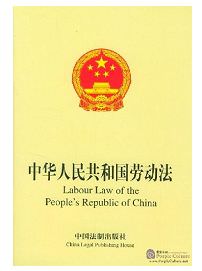
- Enacted by the 28th Session of NPC in June 2007
- Most significant piece of employment-related legislation over a decade
- Objective: redress and improve the poor working conditions and clarify the rights and obligations of employees and employers
China’s Labour Contract Law
- Key issues covered by the LCL:
- Concept of an employment relationship
- Form of labour contract
- Probation period
- Full-time training provided free of charge
- Termination of a labour contract
- Payment of severance pay
- Non-compete clause
- Trade unions
- Dispatch
Concept of an employment relationship
- Problems of the 1995 Labour Law (the old law):
- Although the old law required a written contract, many did not comply with such requirement
- At the time the LCL came into force in 2008, 60-80% of workers did not have a written contract
- Even in cases of written contracts, the terms and conditions were vaguely stated
- New features of the LCL:
- A written labour contract must be concluded within 1st month of employment, otherwise statutory penalties will apply
- Penalties:
Time of contract conclusion Penalty After the 1st month but within one year The employer shall pay the employee twice the amount of the monthly salary After the first year The employer shall pay the employee twice the amount of the monthly salary; AND
The employee will be automatically entitled to a non-fixed term contract
- New features of the LCL:
- Alternatively, if an employee refuses to sign a written contract within the 1st month, the employer is entitled to terminate the employment by written notice
- No severance pay is required
Form of labour contract
- 4 forms of labour contract:
| Types of contract | Termination |
| Fixed-term contract | Contains an agreed termination date |
| Non-fixed-term contract |
No agreed termination date * Art 14 of LCL: a non-fixed-term contract is deemed to exist if an employee is employed for continuous 10 yrs for the same employer AND the employee is 10 yrs away from his/her statutory retirement age OR the contract is renewed after consecutive conclusion of two fixed-term contracts |
| Project-based contract | Terminable upon completion of the project |
|
Casual employment (remuneration calculated on an hourly basis) |
Terminable at any time without notice and severance pay No probation required * The employment must not exceed 4 hrs per day and 24 hrs per week on average |
Probation period
- Article 19 of LCL:
| Term of the labour contract | Maximum probation period |
| Less than 3 months or task-based contract | Nil |
| 3 months to less than 1 year | 1 month |
| 1 year to less than 3 years | 2 months |
| 3 years or more | 6 months |
| No fixed term | 6 months |
During probation, wages cannot be below (Article 20 of LCL):
- the minimum enterprise wage; or
- 80% of the formal wage in the labour contract; or
- the minimum wage of the local standard
Training agreement
- An employer may enter into an agreement with an employee specifying the period of service
- A penalty is payable by the employee to the employer if he/she decides to terminate the agreement prior to its expiry
- The penalty must not exceed the portion of training expenses attributable to the unfulfilled service period and must not exceed the total training expenses paid by the employer
Termination
- Termination by consent
- A labour contract can be terminated by mutual consent
- Termination by employee
- During probation: 3 days notice
- Post probation: 30 days notice
- Termination by employee where no notice required (Article 38 of LCL):
- The employer fails to provide labour protection or work conditions as stipulated in the labour contract
- The employer fails to pay on time
- The employer fails to pay social security contribution
- The rules and procedures stipulated by the employer violate the laws and regulations and infringe the rights and interests of the employee
- The employer forces the employee to work by violence, restraints on employee’s freedom or the work threatens his/her life
- Termination by employer without notice (Article 39 of LCL):
- The employee does not meet the recruitment conditions during the probation period
- The employee violates the rules and procedures stipulated by the employer
- The employee causes severe damage to the employer due to negligence
- The employee enters into another employment in conflict with the current employment
- The employee is under investigation for criminal liabilities
- Termination by employer with 30 days notice or 1 month’s payment in lieu of notice (Article 40 of LCL):
- The employee is sick or injured for non-work-related reasons and cannot resume to work after a prescribed time
- The employee is incompetent even after training or change of job position
- Change of circumstances under which the contract is no longer performable
- Mass redundancy
- More than 20 OR 10% of total employees being made redundant, whichever the lower
- The employer must give 30 days notice with explanation to the labour union and the employees
Severance payment
- Payable upon
- termination by the employer
- employment not renewed after expiry not on the employee’s request AND/OR the employer offers less favourable terms on renewal
| Length of service | Amount of severance pay |
| Less than 6 months | Half month’s wage |
| More than 6 months | One month’s wage |
Non-competition clause
- Article 23 of LCL shortens the max period of non-competition from 3 yrs to 2 yrs
- Such clause could only apply to senior management, technical personnel or personnel with access to trade secrets
- Such employees may be required to sign confidentiality and non-compete agreements
- Financial compensation or damages payable
Trade unions
- Article 51 of LCL:
- A collective contract can be entered into between the employer and the trade union on behalf of its members after equal bargaining
- Article 52 of LCL:
- “Specialised Collective Contracts” introduced to address certain issues such as labour safety and hygiene, protect of female workers and wage adjustment
Dispatch workers
- Workers from one firm tendering service to another firm
- All dispatch workers must be engaged under fixed term contracts for a period not less than 2 years and on at least minimum wage on a monthly basis
Social Security Law (“SSL”) and foreigners’ participation
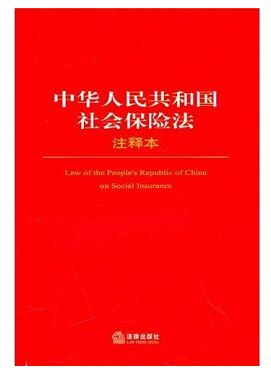
- For the first time, according to Article 97 of SSL, foreign nationals working in the PRC must participate in the PRC social security system
- However, the SSL leaves details of implementation of the Law uncertain
- The “Interim Measures for the Participation of Foreigners Employed in China in the Chinese Social Security System” (the “Interim Measures”) supplements the SSL regarding application on foreign nationals
- Definition of “foreigners” required to participate in the system
- Non-PRC national with PRC work permit and residence permit
- Non-PRC national with “Alien Permanent Residence Permit” and legally employed in PRC
- Definition of “employers”
- Any enterprises or organisations legally registered in the PRC
- Branches or representative offices of foreign enterprises in PRC which have employed workers ‘seconded’ to PRC from overseas
- Types of social security insurance required to be paid by foreign employees and their employers:
| Foreign employees | Employers |
| Basic pension fund | Basic pension fund |
| Basic medical insurance | Basic medical insurance |
| Unemployment insurance | Unemployment insurance |
| Work-related injury insurance | |
| Maternity insurance |
- Registration
- The employer must have registration done for social security for its foreign employees within 30 days after having obtained work permit
- Rate: varies in different locations
| Beijing | Shanghai | |
| Employees’ maximum contribution (monthly) | RMB1,289 | RMB1,289 |
| Employers’ maximum contribution (monthly) | RMB4,386 | RMB4,360 |
- Non-compliance (Article 11 of the Interim Measures)
- Maximum penalties for employees:
- – 3 times the outstanding social security contribution
- Maximum penalties for employers:
- – 0.05% of outstanding contribution per day after expiry plus 1 to 3 times the overdue amount
- Maximum penalties for employees:
- Foreigners’ benefits upon leaving China prior to retirement age
- retain his/her social insurance account and resume the contribution upon returning to work in China; OR
- terminate the social insurance account and receive the lump sum balance of the account upon written application
- If the foreigner is deceased, the balance in the account can be inherited in accordance with the law
- For those eligible to receive pension residing overseas, he/she is required to provide a certificate of being alive once per year
- Dispute resolution
- Arbitration, mediation or bring a claim against the other party
- For state employers, the employees may lodge a complaint at relevant social insurance authority
- Bilateral social insurance agreements
- German and South Koreans employees and their employers are partially exempted from contribution in PRC
- Only required to contribution items not covered by the bilateral agreements between the governments
Enforcement of Social Insurance Contribution Requirements
- Social security contribution registration deadline and date of first contribution:
Employed before 15 Oct 2011 Employed after 15 Oct 2011 Registration deadline 31 Dec 2011 Date of commencement of employment Date of first contribution 15 Oct 2011 Date of commencement of employment - Beijing:
Employed before 31 Oct 2011 Employed from 1 Nov 2011 Registration deadline 31 Dec 2011 31 Dec 2011 Date of first contribution Oct 2011 Date of commencement of employment - Chengdu
- Hong Kong, Macau and Taiwan legally working in China are required to participate
- A sixth category of contribution: “Catastrophic Medical Insurance”
- Shanghai
- Participation of foreign employees remains optional
- Guangzhou, Hangzhou and Tianjin
- Actual rules of implementation largely subject to oral interpretation of local tax bureau officials
- Shenzhen
- Only three categories are required for contribution: Pension, medical care and work-related injury insurance
Subject to local variations…
OTHER RECENT CHANGES TO CHINA’S COMPANY AND BUSINESS LAWS
Representative Offices
Regulations for the Administration of Registration of Resident Representative Offices of Foreign Enterprises (“Regulations”)
- Came into effect on 1 March 2011
- Clarify provisions of the Notice on Strengthening the Registration Administration of Foreign Enterprises’ Resident Representative Offices issued in January 2010 (“Notice”)
- Tighten rules on establishment and operation of rep offices in China
Regulations repeat Notice provisions that:
- A foreign enterprise must have existed for at least 2 years in order to establish a China rep office (i.e. can no longer use new offshore holding co or SPV to establish rep office)
- China rep office can have no more than 4 foreign representatives (including the foreign chief representative)
- Regulations expand on scope of permitted non-profit making activities:
- market survey, exhibition, and publicity activities relating to foreign entity’s products/services
- liaison activities relating to foreign entity’s product sales, service provision, domestic procurement and investment
- Impose new annual reporting obligation – rep offices required to submit annual report to local Administration for Industry and Commerce (AIC) between 1 March and 30 June
- Duration: the Regulations provide that a rep office may have the same term as the foreign parent entity
- However the Notice requires annual renewal of rep office registration certificates
- Level of penalties have been increased including:
- Penalties for engaging in for-profit business activities include a fine of up to RMB500,000, confiscation of illegal profits and equipment/raw materials used in for-profit activities
- Penalties for conducting activities without registering a rep office include a fine of up to RMB200,000
- Rep offices must announce their establishment and changes to their registration through media appointed by the AIC
Foreign Invested Partnerships
- The Partnership Enterprise Law was originally introduced in 1997 and amended in August 2006 and June 2007
- Administrative Measures on the Establishment of Partnership Enterprises in China by Foreign Enterprises and Individuals (“FIP Measures”) and their implementing rules came into effect on 1 March 2010
- FIP can be either wholly foreign-owned partnership – formed by two or more foreign entities and/ or foreign individuals – or a joint venture partnership between foreign entities/individuals with Chinese partner(s) (an FIE but not a China holding company can be a partner)
Liability: FIPs can be either:
- general partnerships – partners have unlimited joint and several liability for obligations of the FIP
- limited liability partnerships – only the general partner(s) has unlimited liability – liability of other partners is limited to the amount of their contribution
Establishment
- Unlike FIEs, establishment of FIPs does not require MOFCOM approval
- Establishment must be registered with SAIC or its designated local bureau
- Investments by FIPs must comply with restrictions on foreign investment including under the Foreign Investment Catalogue
- SAIC implementing rules prohibit registration of FIPs whose investment policy includes investment in “prohibited” industries and “restricted” industries that are either reserved for equity or contractual joint ventures or require a majority shareholding by a Chinese party
- FIP Measures provide that FIPs listing investment as their principal business must also comply with relevant national regulations on FIPs – source of uncertainty
- Despite lack of national regulations, SAIC appears to have concluded that AICs at provincial level offices have authority to register private equity funds formed as FIPs
- SAFE has yet to issue rules on how FIPs should convert capital to RMB for equity investment
- 2008 circular published by SAFE restricts FIEs’ use of converted RMB for equity investment – regarded as obstacle to FIP’s foreign currency conversion
FILM INDUSTRY
China Film Industry
Box Office Revenue (in USD billion)
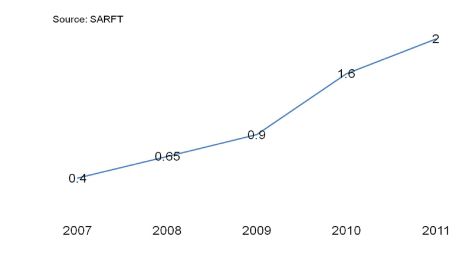
Number of Screens
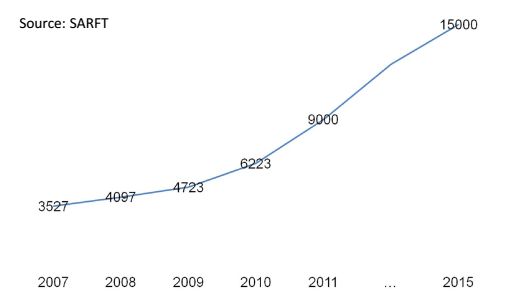
Shares of China box office 2011
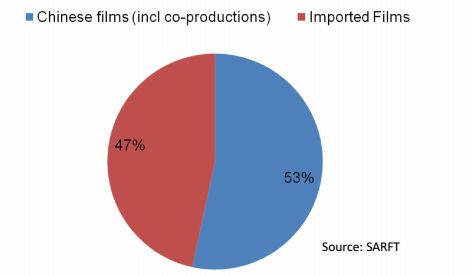
A state controlled industry
Department responsible for the film industry:
The State Administration of Radio, Film and Television
(SARFT)
國家廣播電影電視總局
- Imported films:
- Quota system: only 20 foreign films are allowed into China
- Revenue-sharing basis: the foreign producer shares about 13% of the box office
- Alternatively, Flat-rate basis: the foreign producer sells the distribution rights to authorised distributors in China
- The only authorised distributors in China:
- China Film Group Corporation, Huaxia Film Distribution
- Censorship review a must
Top 10 foreign films in the PRC by box office (2010)
| Title | Box Office (RMB million) | Production Companies |
| Avatar | 1,382 | Fox, Lightstorm Entertainment in association with Dune Entertainment and Ingenious Film Partners |
| Inception | 460 | Warner Brothers Pictures, Syncopy, in association with Legendary |
| Alice in Wonderland | 234 | Walt Disney Pictures, Roth Films, Team Todd, The Zanuck Company |
| The Expendables | 219 | Millennium Films, Nu Image, Rogue Marble |
| Harry Potter and the Deathly Hallows: Part 1 | 213 | Warner Bros, Heyday Films |
| Iron Man 2 | 179 | Paramount, Marvel Entertainment, Marvel Studios, in association with Fairview Entertainment |
| Clash of the Titans | 176 | Warner Bros, Thunder Road Pictures, The Zanuck Company, in association with Legendary |
| Prince of Persia: The Sands of Time | 163 | Walt Disney Pictures, Jerry Bruckheimer Films |
| Resident Evil: Afterlife | 138 | Constantin Film Production, Davis-Films, Impact Pictures |
| Toy Story 3 | 120 | Pixar Animation Studios, Walt Disney Pictures |
(Source: Derived from China Film Association: 2010 Chinese Film Market Review)
- China – foreign co-productions:
- Not subject to the quota system on foreign films
- Revenue-sharing: on a negotiated basis. Generally gives the foreign producer a larger share than imported films
- May have multiple parties on each side
- The Chinese party must have obtained Film Production Licences from SARFT
- Hong Kong, Macau and Taiwan production companies are considered foreign
- Censorship review a must
Top 10 local films in the PRC by box office (2010)
| Title | Box Office (RMB million) | Production |
| Aftershock | 673 | Co-production (Huayi Group) |
| Let the Bullets Fly | 480 | Co-production |
| If You Are The One 2 | 335 | Co-production (Huanyi Group) |
| Detective Dee and the Mystery of the Phantom Flame | 292 | Domestic (Huayi Group) |
| Ip Man 2 | 234 | Co-production |
| Sacrifice | 188 | Domestic |
| Little Big Soldier | 162 | Co-production |
| Just Call Me Nobody | 154 | Domestic |
| Hot Summer Days | 147 | Co-production |
| 14 Blades | 145 | Co-production |
(Source: Derived from China Film Association: 2010 Chinese Film Market Review)
- Why China – foreign co-productions?
- Abundant resources at a low cost
- Access to the explosive growth of China’s market
- Increased international interest in films with Chinese elements
- Access to international market
- Avoid the cap on foreign films (for joint production)
| Top Ten International Box Office Chart 2007 including Hong Kong, Macao and Taiwan | |||||
| No | Titles | Global B.O. (mil. Yuan) | Asian B.O. (mil. Yuan) | European B.O. (mil. Yuan) | North American B.O. (mil. Yuan) |
| 1 | Curse of the Golden Flower | 311.1367 | 83.1405 | 114.9039 | 113.0923 |
| 2 | Lust, Caution* | 305.7207 | 208.7049 | 64.1793 | |
| 3 | Warlords* | 240.00 | 240.00 | ||
| 4 | Painted Veil* | 182.226 | 6322.31 | ||
| 5 | Assembly* | 128.00 | 128.00 | ||
| 6 | Fearless* | 81.5737 | 78.2296 | ||
| 7 | My wife is a Gangster* | 73.2871 | 73.2871 | ||
| 8 | Battle of Wits* | 70.0639 | |||
| 9 | Secret | 62.3324 | |||
| 10 | Invisible Target | 51.3167 | |||
* Co-productions
Source: China Film Co-production Corporation
Regulations on co-production
- Procedures for approval of a co-production project:
- Procedures for approval of a co-production project:
- Conducting post-production overseas: SARFT approval needed
- Censorship review by SARFT (if fail to pass, the film cannot be shown in China or anywhere in the world)
- Participating in film festivals: the plan to participate must be reported to SARFT 20 days in advance
- Co-production partner: qualified PRC production entities accredited by SARFT e.g. Huayi Brothers
- Mode of co-production:
A. Joint Production
- Joint investment
- Share profit, risk and ownership of copyright
- Chinese actors/actresses constitute at least one-third of the main cast
- Chinese personnel constitute at least a half of the crew
- Regarded as local production
- Censorship review a must
- B. Assisted Production
- Foreign producers provide capital in return for production services of China producers
- Copyright owned by the foreign producers
- Regarded as foreign production (subject to import quota)
- Censorship review a must
- Mode of co-production
A. Joint Production
The Mummy: Tomb of the Dragon Emperor
China producer:
Shanghai Film Studio
Foreign producers:
Relativity Media
The Sommers Company
Alphaville FilmsB. Assisted Production
Mission: Impossible III
Foreign producers:
Cruise/Wagner
Bad Robot Productions
MI 3 Film
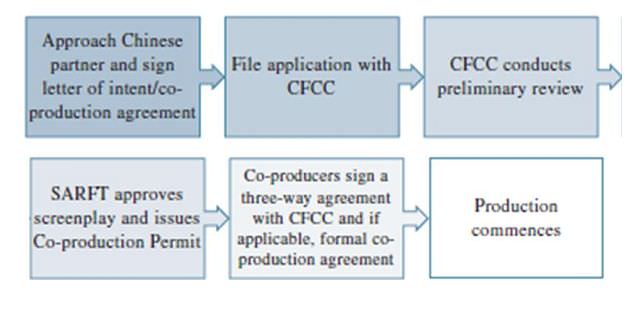
Regulations on film industry
Licence needed:
- Film Production Licence
- Co-production Permit (for co-productions with foreign entities)
- Film Distribution Licence
- Film Exhibition Licence
- Permit for Film Public Screening
- All subject to censorship review by SARFT
Film Distribution Licence:
- Any distribution of films in China is prohibited unless by distributor with Film Distribution Licence
- China Film Group Corporation and Huaxia Film Distribution Co Ltd are the only two companies with the Licence
Co-production: Which mode to adopt?
Factors:
- Nature
- Creative elements
- Division of obligations
- Censorship
- Rights and release of the film
A new US – China deal
- 14 more enhanced format films (IMAX, 3D) will be allowed to enter China
- Box office share of US production studios will increase to 25%
- In effect, 50% more US films will gain access to China’s market
- China allows a US$330 million joint-venture (Oriental DreamWorks) formed between DreamWorks Animation and state-owned production studios
- More local distributors will be allowed to distribute imported films
Censorship Review
Contents endangering / involving:
- PRC constitution
- National unity and territorial integrity
- State secrets/security
- National solidarity
- Evil cults / superstition
- Obscenity, gambling, violence and crimes
- Public ethics
- Legal rights of others
- Any other things prohibited by laws
Ways to get away…
- Avoid all minimally sensitive issues / government’s taboo
- Remove the contents as required
- Create different version for China
HK as the gateway to China – CEPA
HK – produced Chinese language films’ privileges:
- Not subject to import quota
- Cantonese version can be screened in Guangdong
- No personnel requirement on proportion of Chinese crew / cast
- A large pool of expertise and talents from the HK industry
- Impressive track record of success
- HK’s legal and tax system
Turn Left Turn Right (2003)
- American money
- Taiwan story
- Hong Kong cast and crew
Hong Kong producer:
Milkyway Image (HK) Ltd
Foreign producer:
Warner Brothers China
Kung Fu Hustle (2004)
- Martial arts
- Black comedy
- Top grossing foreign film in 2005 in the US
Hong Kong producer:
Star Overseas
Foreign producer:
Columbia Pictures Film
PRC producer:
Huayi Brothers
The Warlords (2007)
- Based on historical events
- Downplayed sensitive themes
Hong Kong producer:
Media Asia Films
PRC producer:
China Film Group
- 4 HK – China produced films in top 10 of 2010 grossed $1.71 billion renminbi

Selecting a partner in China & securing payments
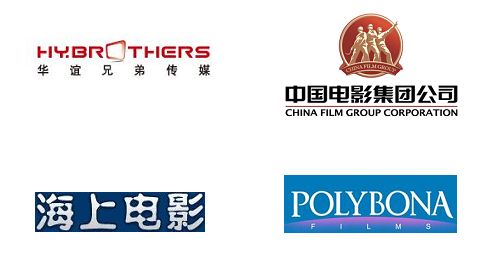
Problems with China box office:
- Not developed; far from transparent and accurate
- No collection agents, escrow account holders or trustees
- Complicated tax system
- Restriction on foreign exchange and remittance
Possible solutions:
- Re-structure co-production agreement – cash first
- Appoint independent inspector of box office
- Count cinema attendance by taking photos at the beginning of each session





